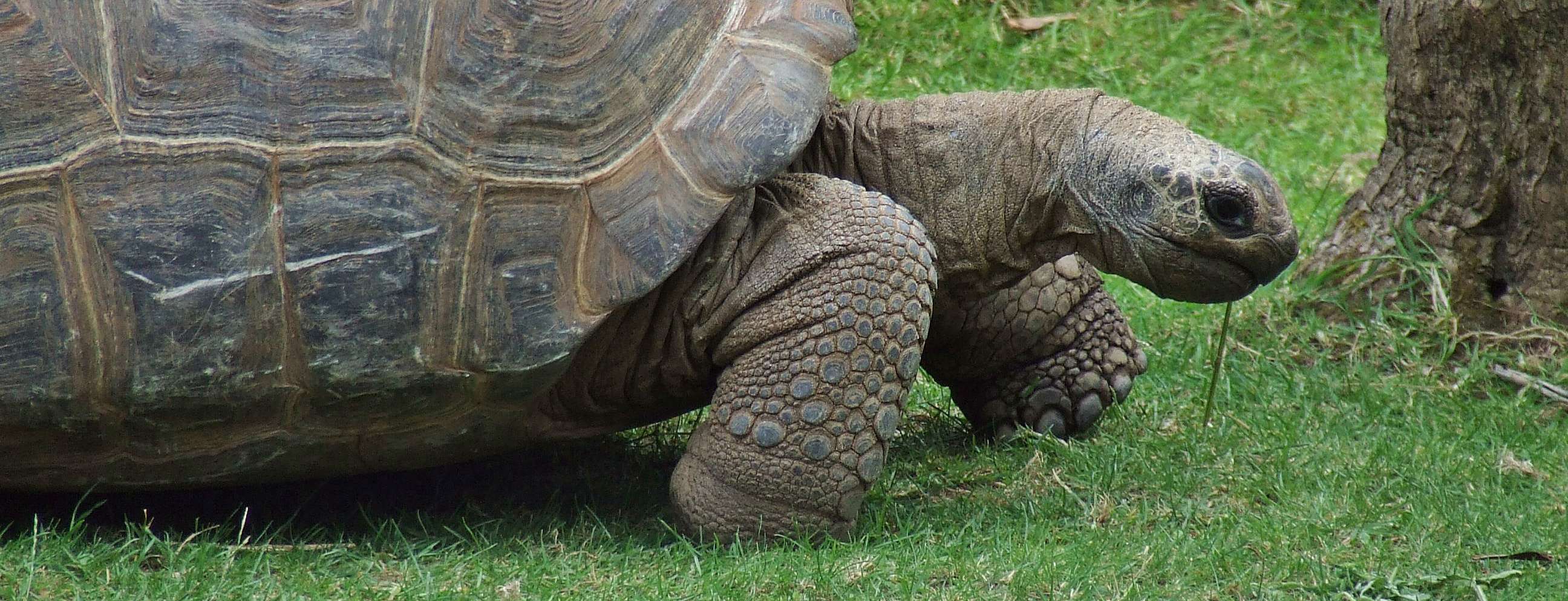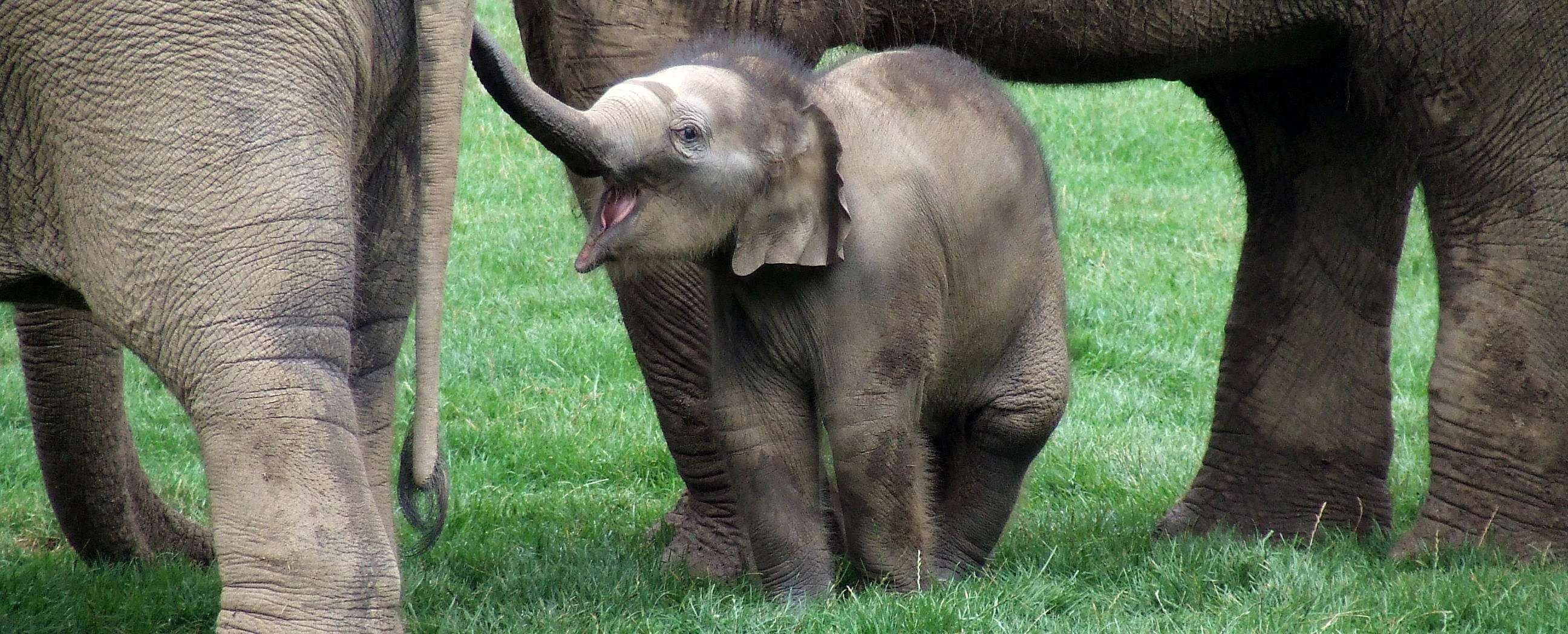Európa állatkertjei
ZOOlogical Gardens of EuROPE
Mixed-species exhibits with Pigs (Suidae)
Written by KRISZTIÁN SVÁBIK
Team Leader, Toni’s Zoo, Rothenburg, Luzern, Switzerland
Uploaded: 9th May 2021
INTRODUCTION
Mixed-species exhibits with different mammals in the last few decades became a major trend. The success of a mixed-species exhibit depends on how we can take general animal husbandry criteria into account in more complex ways in comparison with a single-species exhibit. Those general rules that are important in animal exhibitry are still valid to a greater extent when presenting a multi-species captive environment. As many articles and other publications deal with the subject of general advantages and disadvantages of the mixed-species exhibits, instead of this, here I will assemble a detailed list of mixed exhibits involving at least one member of Suidae. The main aim of these documents is to summarize data and experiences about this exhibitry type with the hope that these manuals will be useful supplement for the husbandry guidelines of different species.
The most important aspects of a successful mixed exhibit are the purposeful use of space and enclosure furnishings, the appropriate feeding techniques, decision-making of which species we want to breed and the right choice of species and individuals.
Use of space and enclosure furnishings
Generally speaking, one of the most critical factor is the size of the area: the larger the enclosure, the fewer the problems. Expanding the size of the whole captive habitat we can greatly increase the chances that the specimens of the different species are able to get out of each other’s way. Although this quantitative factor is also important, however, the quality of the given enclosure is much more crucial, since these agents can ensure the stress-free socialization of the combined species. It is extremely important to provide a secure outdoor and indoor space for the subdominant specimens whether belonging to the same species or not. The outdoor exhibit should be well-structured with many kinds of enclosure furnishing elements like small mounds, logs, rock formations and heavily planted areas so that the animals can get out of visual contact with others sharing the same enclosure and provide several escape routes in case of an aggressive contact between the different species. The best option is if the subdominant species have their own areas both outdoors and indoors.
Feeding
In terms of the daily routine tasks using the appropriate feeding techniques is one of the key factor of success. The experiences show that in several cases the associated species can be easily competitors odf each other in reference of nutrition. Therefore it is necessary to feed the smaller species separately or provide as many feeding stations as possible throughout the whole enclosure and keep the competition to a minimum level, because most of the injuries and lethal accidents are the results of food-related aggression. In general, feeding the different species separately is a participating factor to manage the mixed-species exhibit successfully, but on the other hand this makes it difficult to apply certain food-related environmental enrichment methods in comparison with a single-species enclosure.
Breeding
One of the most important question is to decide whether we would like to breed the species involved in a multi-species exhibit, or which species we want to breed. The practice of zoos keeping suids in a mixed exhibit shows that the presence of these omnivorous animals means potential danger for the other species when they are dominant in the given coexistence. Providing the abovementioned own areas or total separation can be the solution during the time of rearing the young. Furthermore, the behavioural changes of the adult animals during the breeding season must also be borne in mind which may easily lead to fatal injuries. Therefore it is really important to emphasize the possibility of proper separation. Generally speaking it seems to be true that the proper management of breeding in a mixed-species enclosure is more difficult – or sometimes impossible – than in a single-species exhibit. As a result, there is no aim to breed (all) the animals in this type of exhibitry in many cases, so sterilisation and single-sex grouping are also applied techniques in managing. If any of the species has an important breeding programme like SSP or EEP, it is worth to look over and analyse all the mentioned disadvantages before putting the given animals into a mixed enclosure.
Choice of species and individuals
According to the criteria of species selection, most of the known examples show that zoos exhibit animals together from the same geographic region for educational purposes. In case of combining species that occupy similar ecological niches in nature the level of competition can be very high, therefore a large difference in body size between the combined species may be part of the solution. Choosing animals with different lifestyles – for example terrestrial-arboreal or diurnal-nocturnal – might be a good option as well. Although considering the theoretical approaches of the appropriate selection of species are also very important, we have to take into account that the success of the combination depends mostly on the individual level, simply because of the diverse individual characteristics of the animals in terms of behaviour. Correct introduction of the different species is a very sensitive issue which depends principally on the method of socialization and age of the animals. Introducing the smaller and subdominant species to the exhibit can be efficient due to exploring the whole area. During the socialization the principle of gradience should be followed, so visual and olfactory stimuli have to be the first before the possibility of physical contact of the animals. In general younger animals can be combined easier, but the experiences have shown us that many adults suid specimens have successfully been mixed with several other taxa.
List of mixed-species exhibits involving Suids
This document purposefully focuses on creating a list of mixed-species exhibits with family Suidae, for further and detailed information it is worth contacting the institutions mentioned below. Only a short summary of the general experiences is given here. Many of the listed coexistences are still ongoing at present; many of them are not anymore.
Within the narrower meaning of the mixed-species exhibits this document deals with eight species of Pigs.
In the list below you can see which species have been kept in mixed exhibits in captivity:
Pigs, Suidae
Sulawesi Babirusa, Babyrousa celebensis Deninger, 1910
Common Warthog, Phacochoerus africanus Gmelin, 1788
Giant Forest Hog, Hylochoerus meinertzhageni Thomas, 1904
Bushpig, Potamochoerus larvatus F. Cuvier, 1822
Red River Hog, Potamochoerus porcus Linnaeus, 1766
Visayan Warty Pig, Sus cebifrons negrinus Sanborn, 1952
Bearded Pig, Sus barbatus Müller, 1838
Eurasian Wild Boar, Sus scrofa Linnaeus, 1758
Domestic Pig, Sus scrofa f. domestica
LIST OF SPECIES COMBINATIONS - SUIDAE
The list shows examples of species combinations with at least one pig species combined with the taxa below
Sulawesi Babirusa, Babyrousa celebensis (Photo © Krisztián Svábik)
Tonkean Macaque, Macaca tonkeana
White-handed Gibbon, Hylobates lar
Siamang, Symphalangus syndactylus
Patagonian Mara, Dolichotis patagonum
Asian Small-clawed Otter, Aonyx cinereus
Malayan Tapir, Tapirus indicus
Domestic Pig, Sus scrofa f. domestica
Alpaca, Vicugna vicugna f. pacos
Lowland Anoa, Bubalus depressicornis
Domestic Water Buffalo (Kerabau), Bubalus arnee f. bubalis
Milky Stork, Mycteria cinerea
Great Argus Pheasant, Argusianus argus
Sarus Crane, Antigone antigone
Aldabra Giant Tortoise, Aldabrachelys gigantea
Common Warthog, Phacochoerus africanus (Photo © Krisztián Svábik)
African Elephant, Loxodonta africana
Patas Monkey, Erythrocebus patas
White-naped Mangabey, Cercocebus atys lunulatus
Mt. Kenya Guereza, Colobus guereza kikuyuensis
Hamadryas Baboon, Papio hamadryas
Crested Porcupine, Hystrix cristata
Cape Porcupine, Hystrix africaeaustralis
Meerkat, Suricata suricatta
Banded Mongoose, Mungos mungo
Bat-eared Fox, Otocyon megalotis
Somali Wild Ass, Equus africanus somaliensis
Plains Zebra, Equus quagga
Grant’s Zebra, Equus quagga boehmi
Maneless Zebra, Equus quagga borensis
Burchell’s Zebra, Equus quagga burchellii
Chapman’s Zebra, Equus quagga chapmani
Grevy’s Zebra, Equus grevyi
Southern White Rhinoceros, Ceratotherium simum simum
Bushpig, Potamochoerus larvatus
Domestic Pig, Sus scrofa f. domestica
Llama, Lama guanicoe f. glama
Fallow Deer, Dama dama
Nyala, Tragelaphus angasii
Mountain Bongo, Tragelaphus eurycerus isaaci
Greater Kudu, Tragelaphus strepsiceros
Lesser Kudu, Tragelaphus imberbis
Common Eland, Tragelaphus oryx
Giant Eland, Tragelaphus derbianus
Topi, Damaliscus korrigum jimela
Bontebok, Damaliscus pygargus pygargus
Blesbok, Damaliscus pygargus phillipsi
Waterbuck, Kobus ellipsiprymnus
Defassa Waterbuck, Kobus ellipsiprymnus defassa
Ugandan Kob, Kobus kob thomasi
Red Lechwe, Kobus leche leche
Common Impala, Aepyceros melampus
Springbok, Antidorcas marsupialis
Cuvier's Gazelle, Gazella cuvieri
Slender-horned Gazelle, Gazella leptoceros
Thomson's Gazelle, Eudorcas thomsonii
Dama Gazelle, Nanger dama
Soemmerring's Gazelle, Nanger soemmerringii
Scimitar-horned Oryx, Oryx dammah
Arabian Oryx, Oryx leucoryx
Roan Antelope, Hippotragus equinus
Sable Antelope, Hippotragus niger
Zambian Sable Antelope, Hippotragus niger kirkii
Common Wildebeest, Connochaetes taurinus
Cape Buffalo, Syncerus caffer
African Forest Buffalo, Syncerus caffer nanus
Domestic Cattle, Bos primigenius f. taurus
Ankole-Watusi Cattle, Bos primigenius f. taurus
Domestic Water Buffalo, Bubalus arnee f. bubalis
Giraffe, Giraffa camelopardalis
Reticulated Giraffe, Giraffa camelopardalis reticulata
Rothschild's Giraffe, Giraffa camelopardalis rothschildi
Masai Giraffe, Giraffa camelopardalis tippelskirchi
Aoudad, Ammotragus lervia
Ostrich, Struthio camelus
North African Ostrich, Struthio camelus camelus
South African Ostrich, Struthio camelus australis
Somali Ostrich, Struthio molybdophanes
Greater Rhea, Rhea americana
Marabou, Leptoptilos crumenifer
Saddle-billed Stork, Ephippiorhynchus senegalensis
Pink-backed Pelican, Pelecanus rufescens
Ruddy Shelduck, Tadorna ferruginea
Rüppell's Vulture, Gyps rueppelli
Lappet-faced Vulture, Torgos tracheliotos
Helmeted Guineafowl, Numida meleagris
Crested Guineafowl, Guttera pucherani
Kori Bustard, Ardeotis kori
Grey Crowned-crane, Balearica regulorum
East African Grey Crowned-crane, Balearica regulorum gibbericeps
African Sacred Ibis, Threskiornis aethiopicus
Ground-hornbill, Bucorvus sp.
African Spurred Tortoise, Centrochelys sulcata
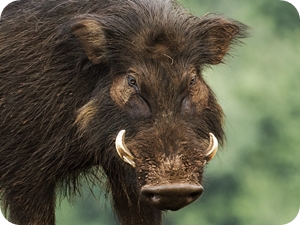 Giant Forest Hog, Hylochoerus meinertzhageni (Photo © Nick Athanas)
Giant Forest Hog, Hylochoerus meinertzhageni (Photo © Nick Athanas)
Bush Duiker, Sylvicapra grimmia
Kirk's Dik-dik, Madoqua kirkii
Bushbuck, Tragelaphus scriptus
Bohor Reedbuck, Redunca redunca
Uganda Kob, Kobus kob thomasi
Defassa Waterbuck, Kobus ellipsiprymnus defassa
Egyptian Goose, Alopochen aegyptiaca
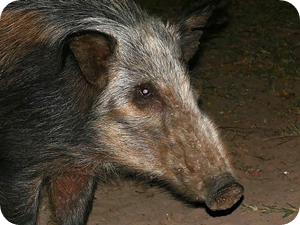 Bushpig, Potamochoerus larvatus (Photo © Bernard Dupont)
Bushpig, Potamochoerus larvatus (Photo © Bernard Dupont)
Common Warthog, Phacochoerus africanus
Red River Hog, Potamochoerus porcus
Cape Buffalo, Syncerus caffer
Red River Hog, Potamochoerus porcus (Photo © Krisztián Svábik)
Rock Hyrax, Procavia capensis
African Elephant, Loxodonta africana
White-naped Mangabey, Cercocebus lunulatus
Diana Monkey, Cercopithecus diana
De Brazza’s Monkey, Cercopithecus neglectus
Guereza, Colobus guereza
Mandrill, Mandrillus sphinx
Western Lowland Gorilla, Gorilla gorilla gorilla
Bonobo, Pan paniscus
Meerkat, Suricata suricatta
Yellow Mongoose, Cynictis penicillata
Banded Mongoose, Mungos mungo
Domestic Cat, Felis catus
Bat-eared Fox, Otocyon megalotis
Spotted-necked Otter, Hydrictis maculicollis
Plains Zebra, Equus quagga
Grant’s Zebra, Equus quagga boehmi
Burchell’s Zebra, Equus quagga burchellii
Chapman’s Zebra, Equus quagga chapmani
Southern White Rhinoceros, Ceratotherium simum simum
Eastern Black Rhinoceros, Diceros bicornis michaeli
Bushpig, Potamochoerus larvatus
Hippopotamus, Hippopotamus amphibius
Pygmy Hippopotamus, Choeropsis liberiensis
Nyala, Tragelaphus angasii
Sitatunga, Tragelaphus spekii
Mountain Bongo, Tragelaphus eurycerus isaaci
Greater Kudu, Tragelaphus strepsiceros
Addax, Addax nasomaculatus
Kob, Kobus kob
Waterbuck, Kobus ellipsiprymnus
Defassa Waterbuck, Kobus ellipsiprymnus defassa
Nile Lechwe, Kobus megaceros
Steenbok, Raphicerus campestris
Common Impala, Aepyceros melampus
Thomson's Gazelle, Eudorcas thomsonii
Mhorr Gazelle, Nanger dama mhorr
Grant's Gazelle, Nanger granti
Roan Antelope, Hippotragus equinus
Common Wildebeest, Connochaetes taurinus
Cape Buffalo, Syncerus caffer
African Forest Buffalo, Syncerus caffer nanus
Ankole-Watusi Cattle, Bos primigenius f. taurus
Dwarf Zebu, Bos primigenius f. taurus
Okapi, Okapia johnstoni
Giraffe, Giraffa camelopardalis
Reticulated Giraffe, Giraffa camelopardalis reticulata
Rothschild's Giraffe, Giraffa camelopardalis rothschildi
Ostrich, Struthio camelus
White Stork, Ciconia ciconia
Saddle-billed Stork, Ephippiorhynchus senegalensis
Marabou, Leptoptilos crumenifer
Great White Pelican, Pelecanus onocrotalus
Pink-backed Pelican, Pelecanus rufescens
Rüppell's Vulture, Gyps rueppelli
Spur-winged Goose, Plectropterus gambensis
Egyptian Goose, Alopochen aegyptiaca
Helmeted Guineafowl, Numida meleagris
Domestic Helmeted Guineafowl, Numida meleagris f. domestica
Wattled Crane, Bugeranus carunculatus
Blue Crane, Anthropoides paradiseus
Grey Crowned-crane, Balearica regulorum
East African Grey Crowned Crane, Balearica regulorum gibbericeps
Black Crowned-crane, Balearica pavonina
Abyssinian Ground-hornbill, Bucorvus abyssinicus
Visayan Warty Pig, Sus cebifrons negrinus (Photo © Krisztián Svábik)
Asian Small-clawed Otter, Aonyx cinereus
Malayan Tapir, Tapirus indicus
Greater One-horned Rhinoceros, Rhinoceros unicornis
Reeves’ Muntjac, Muntiacus reevesi
Tufted Deer, Elaphodus cephalophus
Hog Deer, Axis porcinus
Philippine Spotted Deer, Rusa alfredi
Nilgai, Boselaphus tragocamelus
Blackbuck, Antilope cervicapra
Domestic Water Buffalo, Bubalus arnee f. bubalis
Mishmi Takin, Budorcas taxicolor taxicolor
Golden Takin, Budorcas taxicolor bedfordi
Sichuan Takin, Budorcas taxicolor tibetana
Bearded Pig, Sus barbatus (Photo © Krisztián Svábik)
Greater One-horned Rhinoceros, Rhinoceros unicornis
Altai Wapiti, Cervus canadensis sibiricus
Sika Deer, Cervus nippon
Barasingha, Rucervus duvaucelii
Javan Rusa, Rusa timorensis
Malayan Sambar, Rusa unicolor equina
Chital, Axis axis
Blackbuck, Antilope cervicapra
Pesian Goitered Gazelle, Gazella subgutturosa subgutturosa
Nilgai, Boselaphus tragocamelus
Gaur, Bos gaurus
Chinese Blue Sheep, Pseudois nayaur szechuanensis
Armenian Mouflon, Ovis orientalis gmelini
Eurasian Wild Boar, Sus scrofa (Photo © Krisztián Svábik)
Crested Porcupine, Hystrix sp.
Red Fox, Vulpes vulpes
Greater One-horned Rhinoceros, Rhinoceros unicornis
Indian Muntjac, Muntiacus muntjak
European Roe Deer, Capreolus capreolus
Red Deer, Cervus elaphus
Manitoban Elk, Cervus canadensis manitobensis
Tule Elk, Cervus canadensis nannodes
Vietnamese Sika Deer, Cervus nippon pseudaxis
Dybowski’s Sika Deer, Cervus hortulorum hortulorum
Barasingha, Rucervus duvaucelii
Javan Rusa, Rusa timorensis
Sambar, Rusa unicolor
Chital, Axis axis
Fallow Deer, Dama dama
Blackbuck, Antilope cervicapra
Persian Goitered Gazelle, Gazella subgutturosa subgutturosa
Saiga, Saiga tatarica
Nilgai, Boselaphus tragocamelus
European Bison, Bison bonasus
Javan Banteng, Bos javanicus javanicus
Indian Gaur, Bos gaurus gaurus
Gayal, Bos gaurus f. frontalis
Mouflon, Ovis orientalis musimon
Armenian Mouflon, Ovis orientalis gmelini
Domestic Sheep, Ovis orientalis f. aries
West Caucasian Tur, Capra caucasica
Cretan Wild Goat, Capra aegagrus cretica
Aoudad, Ammotragus lervia
Domestic Pig, Sus scrofa f. domestica (Photo © Krisztián Svábik)
Plains Zebra, Equus quagga
Horse, Equus ferus f. caballus
Shetland Pony, Equus ferus f. caballus
Donkey, Equus africanus f. asinus
Sulawesi Babirusa, Babyrousa celebensis
Common Warthog, Phacochoerus africanus
Llama, Lama guanicoe f. glama
Alpaca, Vicugna vicugna f. pacos
Wapiti, Cervus canadensis
Sika Deer, Cervus nippon
Fallow Deer, Dama dama
Père David's Deer, Elaphurus davidianus
Blackbuck, Antilope cervicapra
Nilgai, Boselaphus tragocamelus
Scimitar-horned Oryx, Oryx dammah
Common Eland, Tragelaphus oryx
American Bison, Bison bison
Domestic Cattle, Bos primigenius f. taurus
Ankole-Watusi Cattle, Bos primigenius f. taurus
Zebu, Bos primigenius f. taurus
Domestic Yak, Bos mutus f. grunniens
Domestic Water Buffalo, Bubalus arnee f. bubalis
Aoudad, Ammotragus lervia
Domestic Goat, Capra aegagrus f. hircus
Domestic Sheep, Ovis orientalis f. aries
Greater Rhea, Rhea americana
Domestic Duck, Anas platyrhynchos f. domestica
Domestic Goose, Anser anser f. domestica
Swan Goose, Anser cygnoid
Knob Goose, Anser cygnoid f. domestica
Domestic Chicken, Gallus gallus f. domestica
LIST OF MIXED-SPECIES EXHIBITS WITH LOCATIONS - SUIDAE
The list shows specific examples of current and historic mixed-species exhibits involving at least one pig species combined with the taxa below, with indication of the institution(s) where they have been tried out
Sulawesi Babirusa, Babyrousa celebensis
Combined species:
- Sulawesi Babirusa, Babyrousa celebensis
- Tonkean Macaque, Macaca tonkeana
Institution(s): Espace Zoologique de Saint-Martin la Plaine (France)
Combined species:
- Sulawesi Babirusa, Babyrousa celebensis
- White-handed Gibbon, Hylobates lar
Institution(s): Toronto Zoo (Ontario, Canada)
*Combined species:
- Sulawesi Babirusa, Babyrousa celebensis
- Siamang, Symphalangus syndactylus
Institution(s): Louisville Zoo (Kentucky, United States of America)
* Animals not always exhibited together
Combined species:
- Sulawesi Babirusa, Babyrousa celebensis
- Patagonian Mara, Dolichotis patagonum
Institution(s): Twycross Zoo (United Kingdom)
Combined species:
- Sulawesi Babirusa, Babyrousa celebensis
- Asian Small-clawed Otter, Aonyx cinereus
Institution(s): Audubon Nature Institute (New Orleans, Louisiana, United States of America), Jacksonville Zoo and Gardens (Florida, United States of America), Chester Zoo (United Kingdom)
Sulawesi Babirusa (Babyrousa celebensis) and Asian Small-clawed Otters (Aonyx cinereus)
Jacksonville Zoo and Gardens, Florida, United States of America
Photo © Fred Hood
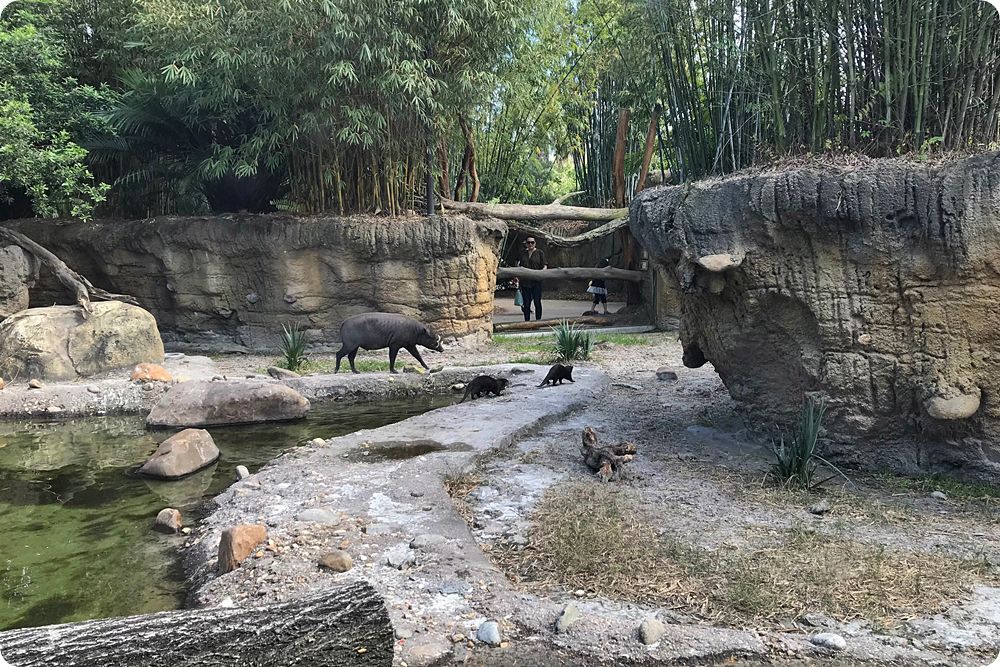
Sulawesi Babirusa (Babyrousa celebensis) and Asian Small-clawed Otter (Aonyx cinereus) mixed exhibit
Jacksonville Zoo and Gardens, Florida, United States of America
Photo © Curby Simerson
Sulawesi Babirusa (Babyrousa celebensis) and Asian Small-clawed Otters (Aonyx cinereus)
Chester Zoo, United Kingdom
Photo © Christopher Holland
Combined species:
- Sulawesi Babirusa, Babyrousa celebensis
- Malayan Tapir, Tapirus indicus
Institution(s): Zoo Aquarium de Madrid (Spain), Münchener Tierpark Hellabrunn (Germany)
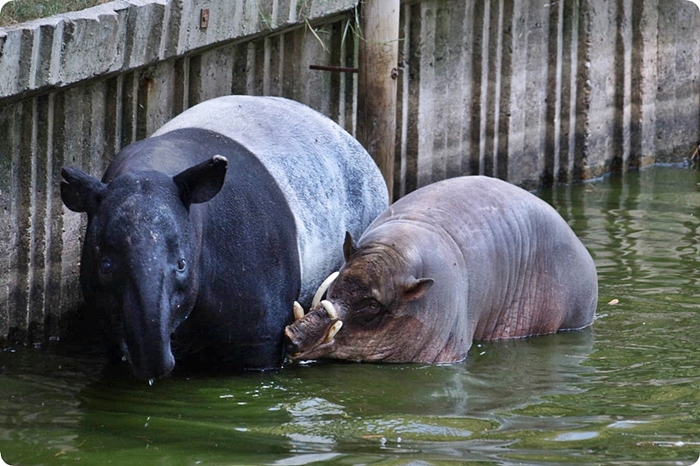
Sulawesi Babirusa (Babyrousa celebensis) and Malayan Tapir (Tapirus indicus)
Zoo Aquarium de Madrid, Spain
Photo © Paco Micó Martínez
Sulawesi Babirusa (Babyrousa celebensis) and Malayan Tapir (Tapirus indicus)
Zoo Aquarium de Madrid, Spain
Photo © Ben Gilbert
Sulawesi Babirusa (Babyrousa celebensis) and Malayan Tapir (Tapirus indicus) mixed exhibit
Zoo Aquarium de Madrid, Spain
Photo © Ben Gilbert
Combined species:
- Sulawesi Babirusa, Babyrousa celebensis
- Domestic Pig, Sus scrofa f. domestica
Institution(s): København Zoo (Denmark), Fővárosi Állat- és Növénykert (Budapest, Hungary), Zoologischer Garten Berlin (Germany)
Sulawesi Babirusa x Domestic Pig (Babyrousa celebensis x Sus scrofa f. domestica) hybrid piglets
København Zoo, Denmark
Photos © Kåre Jensen
Sulawesi Babirusa (Babyrousa celebensis) and Pot-bellied Pig (Sus scrofa f. domestica)
Zoologischer Garten Berlin, Germany
Photo © Théo Vonnez
Combined species:
- Sulawesi Babirusa, Babyrousa celebensis
- Alpaca, Vicugna vicugna f. pacos
Institution(s): Twycross Zoo (United Kingdom)
Combined species:
- Sulawesi Babirusa, Babyrousa celebensis
- Lowland Anoa, Bubalus depressicornis
Institution(s): San Diego Zoo (California, United States of America), Los Angeles Zoo (California, United States of America)
Sulawesi Babirusa (Babyrousa celebensis) and Lowland Anoa (Bubalus depressicornis)
San Diego Zoo, California, United States of America
Photo © www.zoochat.com
Combined species:
- Sulawesi Babirusa, Babyrousa celebensis
- Domestic Water Buffalo (Kerabau), Bubalus arnee f. bubalis
Institution(s): Tierpark Berlin (Germany)
Combined species:
- Sulawesi Babirusa, Babyrousa celebensis
- Milky Stork, Mycteria cinerea
- Great Argus Pheasant, Argusianus argus
Institution(s): Audubon Nature Institute (New Orleans, Louisiana, United States of America)
Combined species:
- Sulawesi Babirusa, Babyrousa celebensis
- Sarus Crane, Antigone antigone
Institution(s): Los Angeles Zoo (California, United States of America)
Combined species:
- Sulawesi Babirusa, Babyrousa celebensis
- Aldabra Giant Tortoise, Aldabrachelys gigantea
Institution(s): Fővárosi Állat- és Növénykert (Budapest, Hungary)
Common Warthog, Phacochoerus africanus
Combined species:
- Common Warthog, Phacochoerus africanus
- African Elephant, Loxodonta africana
Institution(s): Safari de Peaugres (France), Le ZooSafari de Thoiry (France), Parc Zoologique de Paris (France)
Common Warthogs (Phacochoerus africanus) and African Elephants (Loxodonta africana)
Safari de Peaugres, France
Photo © www.aboutzoos.info
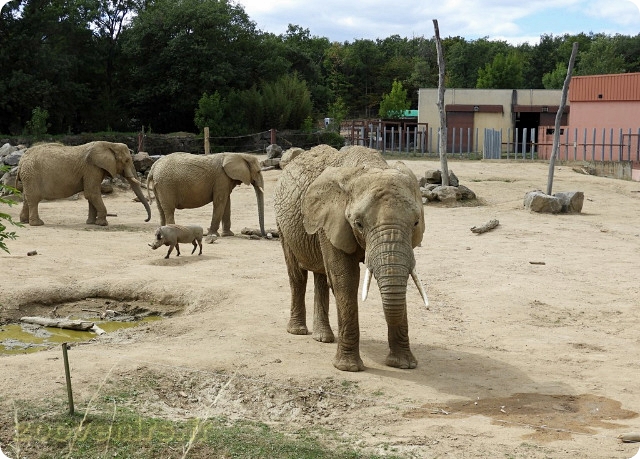
Common Warthog (Phacochoerus africanus) and African Elephants (Loxodonta africana)
Safari de Peaugres, France
Photo © Jonas Livet
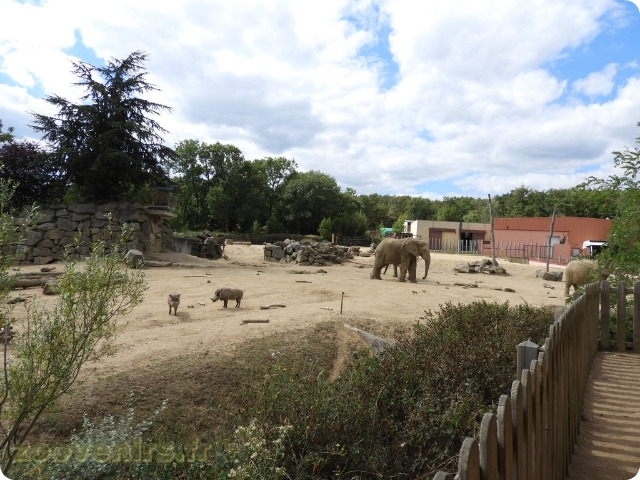
Common Warthog (Phacochoerus africanus) and African Elephant (Loxodonta africana) mixed exhibit
Safari de Peaugres, France
Photo © Jonas Livet
Combined species:
- Common Warthog, Phacochoerus africanus
- Patas Monkey, Erythrocebus patas
Institution(s): Xantus János Állatkert (Győr, Hungary)
Combined species:
- Common Warthog, Phacochoerus africanus
- White-naped Mangabey, Cercocebus atys lunulatus
Institution(s): Zoo Osnabrück (Germany)
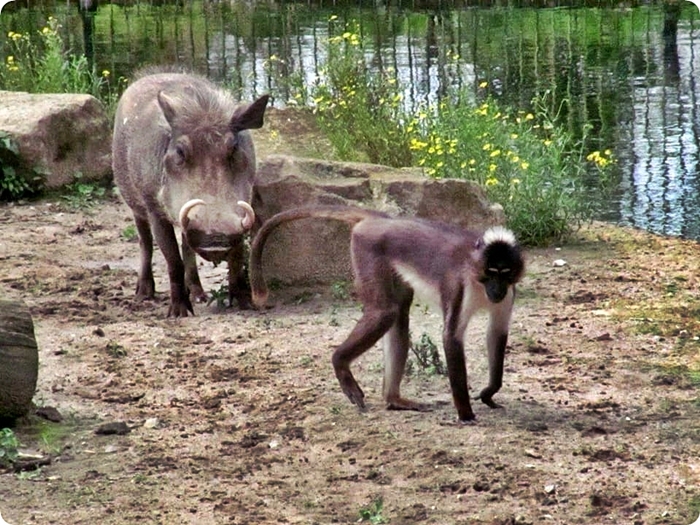
Common Warthog (Phacochoerus africanus) and White-naped Mangabey (Cercocebus atys lunulatus)
Zoo Osnabrück, Germany
Photo © Mario Berndtgen
Combined species:
- Common Warthog, Phacochoerus africanus
- Mt. Kenya Guereza, Colobus guereza kikuyuensis
Institution(s): Zoo Osnabrück (Germany)
Combined species:
- Common Warthog, Phacochoerus africanus
- Hamadryas Baboon, Papio hamadryas
- Aoudad, Ammotragus lervia
Institution(s): Xantus János Állatkert (Győr, Hungary)
Common Warthog (Phacochoerus africanus), Hamadryas Baboon (Papio hamadryas) and Aoudad (Ammotragus lervia) mixed exhibit
Xantus János Állatkert, Győr, Hungary
Photo © Alex Kantorovich
Combined species:
- Common Warthog, Phacochoerus africanus
- Cape Porcupine, Hystrix africaeaustralis
Institution(s): Indianapolis Zoo (Indiana, United States of America)
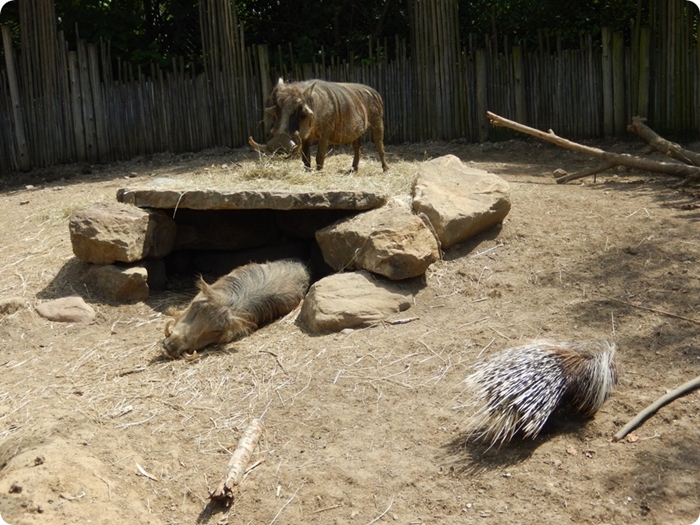
Common Warthogs (Phacochoerus africanus) and Cape Porcupine (Hystrix africaeaustralis)
Indianapolis Zoo, Indiana, United States of America
Photo © Josh Chamberlain
Common Warthog (Phacochoerus africanus) and Cape Porcupine (Hystrix africaeaustralis) mixed exhibit
Indianapolis Zoo, Indiana, United States of America
Photo © Logan Green
Combined species:
- Common Warthog, Phacochoerus africanus
- Crested Porcupine, Hystrix cristata
Institution(s): Franklin Park Zoo (Boston, Massachusetts, United States of America), Detroit Zoo (Michigan, United States of America)
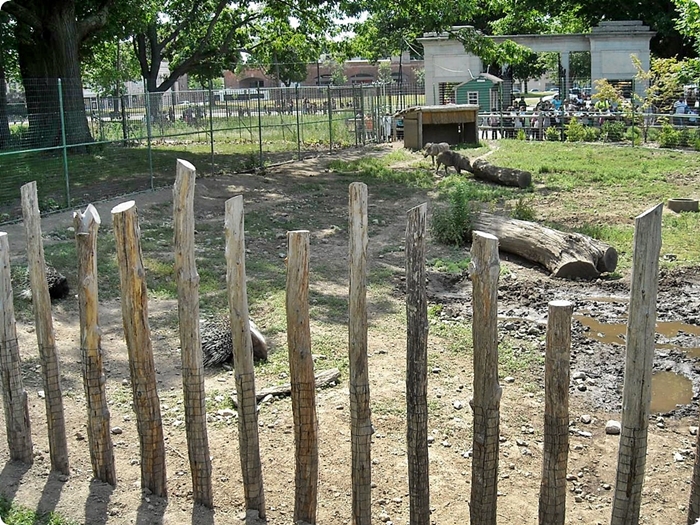
Common Warthog (Phacochoerus africanus) and Crested Porcupine (Hystrix cristata) mixed exhibit
Franklin Park Zoo, Boston, Massachusetts, United States of America
Photo © David Brown
Combined species:
- Common Warthog, Phacochoerus africanus
- Meerkat, Suricata suricatta
Institution(s): Ouwehands Dierenpark (Rhenen, the Netherlands)
Common Warthogs (Phacochoerus africanus) and Meerkats (Suricata suricatta)
Ouwehands Dierenpark, Rhenen, the Netherlands
Photo © Marcel Holtrop
Common Warthog (Phacochoerus africanus) and Meerkats (Suricata suricatta)
Ouwehands Dierenpark, Rhenen, the Netherlands
Photo © www.aboutzoos.info
Common Warthog (Phacochoerus africanus) and Meerkat (Suricata suricatta) mixed exhibit
Ouwehands Dierenpark, Rhenen, the Netherlands
Photo © Gabriella Mótyán
Combined species:
- Common Warthog, Phacochoerus africanus
- Banded Mongoose, Mungos mungo
Institution(s): Chester Zoo (United Kingdom), Haller Park (Bamburi, Mombasa, Kenya)
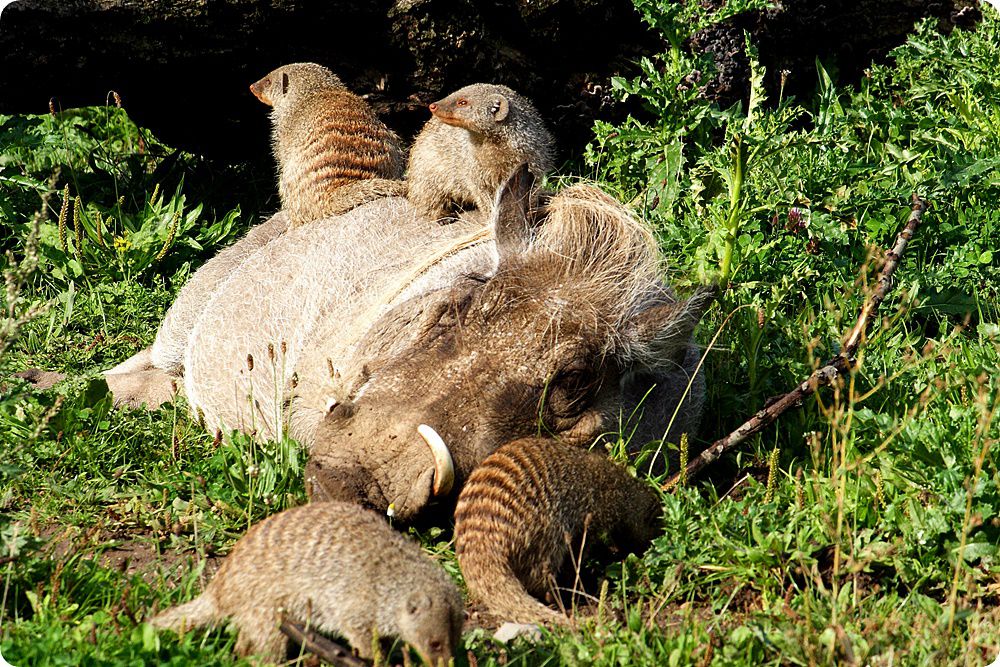
Common Warthog (Phacochoerus africanus) and Banded Mongoose (Mungos mungo) interactive behaviour
Chester Zoo, United Kingdom
Photos © Christopher Holland
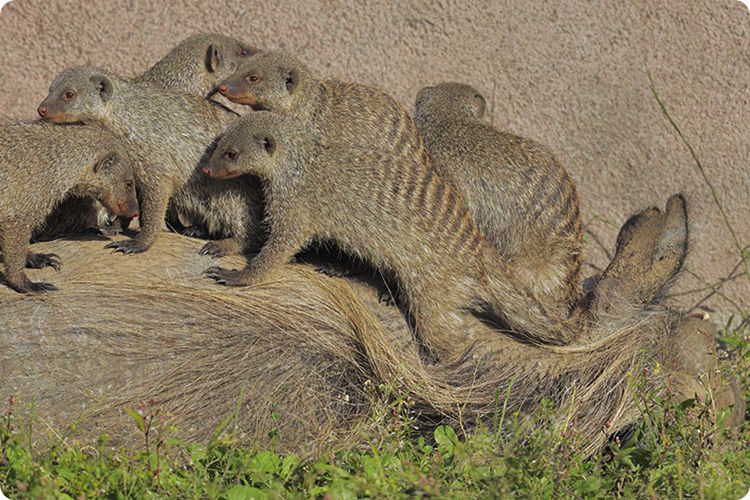
Common Warthog (Phacochoerus africanus) and Banded Mongoose (Mungos mungo) interactive behaviour
Chester Zoo, United Kingdom
Photo © Alan Hill
Common Warthogs (Phacochoerus africanus) and Banded Mongoose (Mungos mungo)
Chester Zoo, United Kingdom
Photo © Krisztián Svábik
Common Warthog (Phacochoerus africanus) and Banded Mongoose (Mungos mungo) mixed exhibit
Chester Zoo, United Kingdom
Photo © Krisztián Svábik
Combined species:
- Southern Warthog, Phacochoerus africanus sundevallii
- Bat-eared Fox, Otocyon megalotis
- earlier Ground-hornbill, Bucorvus sp.
Institution(s): San Diego Zoo Safari Park (California, United States of America)
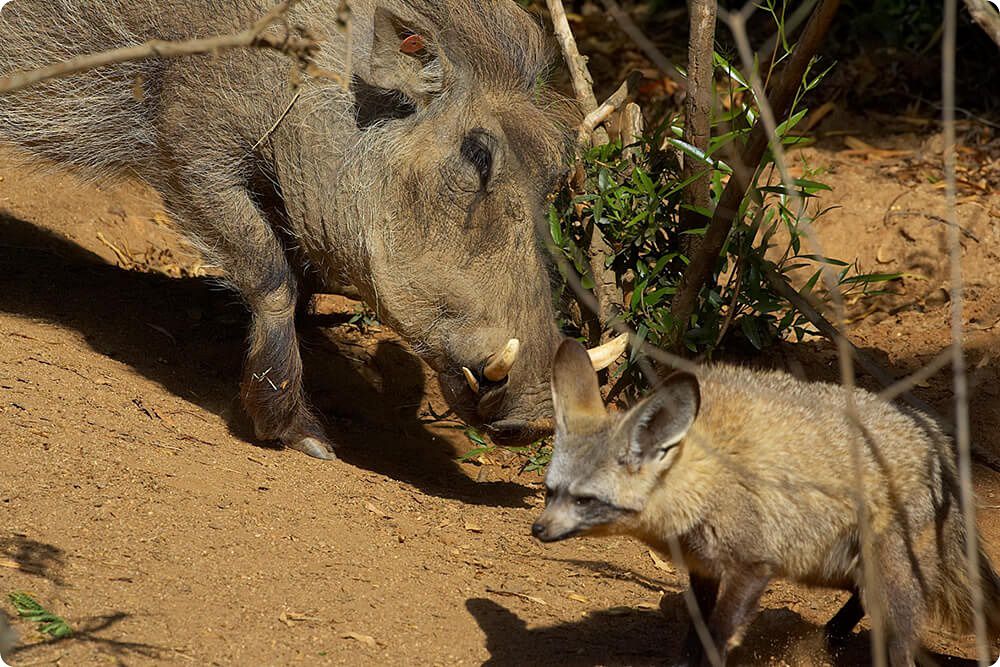
Southern Warthog (Phacochoerus africanus sundevallii) and Bat-eared Fox (Otocyon megalotis)
San Diego Zoo Safari Park, California, United States of America
Photo © San Diego Zoo Safari Park
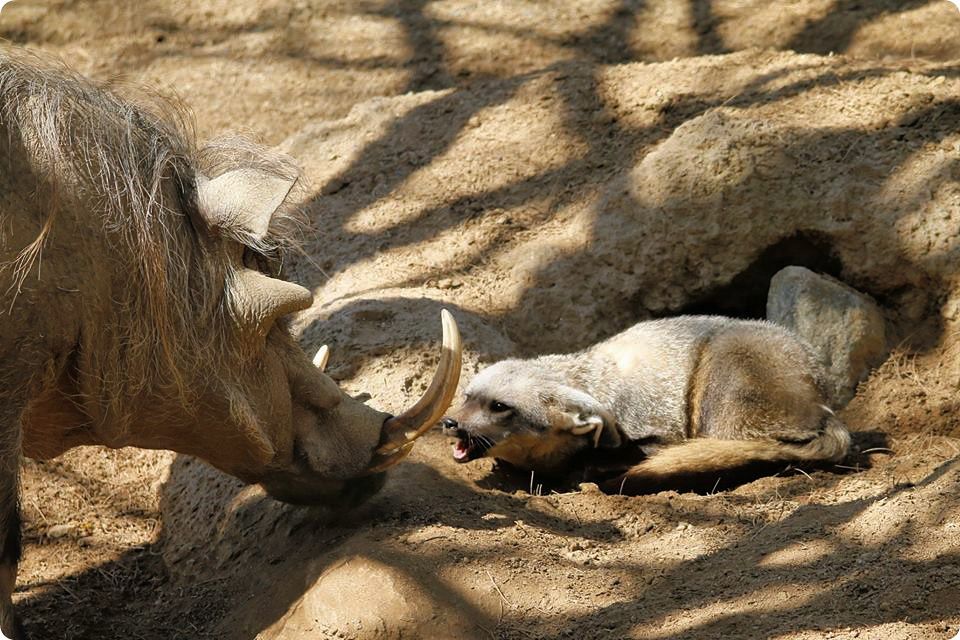
Southern Warthog (Phacochoerus africanus sundevallii) and Bat-eared Fox (Otocyon megalotis)
San Diego Zoo Safari Park, California, United States of America
Photo © MaryAnn Fuller
.png)
Southern Warthog (Phacochoerus africanus sundevallii) and Bat-eared Fox (Otocyon megalotis) mixed exhibit
San Diego Zoo Safari Park, California, United States of America
Photo © Curby Simerson
Southern Warthog (Phacochoerus africanus sundevallii) and Bat-eared Fox (Otocyon megalotis) mixed exhibit
San Diego Zoo Safari Park, California, United States of America
Photo © Scott Richardson
Combined species:
- Common Warthog, Phacochoerus africanus
- Somali Wild Ass, Equus africanus somaliensis
- Cuvier’s Gazelle, Gazella cuvieri
Institution(s): Réserve Africaine de Sigean (France)
Combined species:
- Common Warthog, Phacochoerus africanus
- Grant’s Zebra, Equus quagga boehmi
Institution(s): Fort Worth Zoo (Texas, United States of America), Pécsi Állatkert és Akvárium-Terrárium (Hungary)
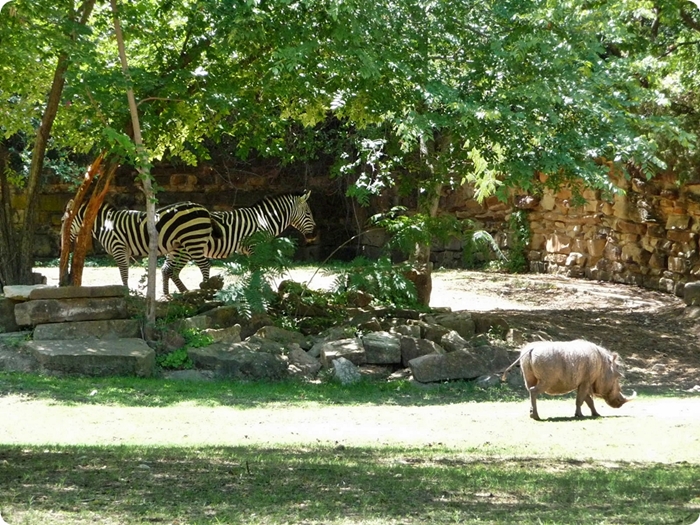
Common Warthog (Phacochoerus africanus) and Grant’s Zebras (Equus quagga boehmi)
Fort Worth Zoo, Texas, United States of America
Photo © Scott Richardson
Combined species:
- Common Warthog, Phacochoerus africanus
- Grant’s Zebra, Equus quagga boehmi
- Springbok, Antidorcas marsupialis
Institution(s): San Diego Zoo (California, United States of America)
Combined species:
- Common Warthog, Phacochoerus africanus
- Grant’s Zebra, Equus quagga boehmi
- Giant Eland, Tragelaphus derbianus
Institution(s): Houston Zoo (Texas, United States of America)
Combined species:
- Common Warthog, Phacochoerus africanus
- Grant’s Zebra, Equus quagga boehmi
- Greater Kudu, Tragelaphus strepsiceros
- Common Impala, Aepyceros melampus
- Dama Gazelle, Nanger dama
- Common Wildebeest, Connochaetes taurinus
- Ankole-Watusi Cattle, Bos primigenius f. taurus
- Masai Giraffe, Giraffa camelopardalis tippelskirchi
- Ostrich, Struthio camelus
- Helmeted Guineafowl, Numida meleagris
Institution(s): Toledo Zoo (Ohio, United States of America)
Combined species:
- Common Warthog, Phacochoerus africanus
- Burchell’s Zebra, Equus quagga burchellii
- Cuvier’s Gazelle, Gazella cuvieri
- Soemmering’s Gazelle, Nanger soemmerringii
Institution(s): San Diego Zoo (California, United States of America)
Combined species:
- Common Warthog, Phacochoerus africanus
- Burchell’s Zebra, Equus quagga burchellii
- Southern White Rhinoceros, Ceratotherium simum simum
- Nyala, Tragelaphus angasii
- Greater Kudu, Tragelaphus strepsiceros
- Common Eland, Tragelaphus oryx
- Bontebok, Damaliscus pygargus pygargus
- Common Impala, Aepyceros melampus
- Springbok, Antidorcas marsupialis
- Scimitar-horned Oryx, Oryx dammah
- Arabian Oryx, Oryx leucoryx
- Sable Antelope, Hippotragus niger niger
- Cape Buffalo, Syncerus caffer
- Ankole-Watusi Cattle, Bos primigenius f. taurus
- Aoudad, Ammotragus lervia
- Marabou, Leptoptilos crumenifer
- Kori Bustard, Ardeotis kori
Institution(s): Safaripark Beekse Bergen (Hivarenbeek, the Netherlands)
Combined species:
- Common Warthog, Phacochoerus africanus
- Chapman’s Zebra, Equus quagga chapmani
- North African Ostrich, Struthio camelus camelus
Institution(s): Tierpark Hagenbeck (Hamburg, Germany)
Common Warthog (Phacochoerus africanus) and Chapman’s Zebra (Equus quagga chapmani)
Tierpark Hagenbeck, Hamburg, Germany
Photo © www.zoochat.com
Combined species:
- Common Warthog, Phacochoerus africanus
- Chapman’s Zebra, Equus quagga chapmani
- Defassa Waterbuck, Kobus ellipsiprymnus defassa
- North African Ostrich, Struthio camelus camelus
Institution(s): Tierpark Hagenbeck (Hamburg, Germany)
Combined species:
- Common Warthog, Phacochoerus africanus
- Chapman’s Zebra, Equus quagga chapmani
- Nyala, Tragelaphus angasii
- Mountain Bongo, Tragelaphus eurycerus isaaci
- Greater Kudu, Tragelaphus strepsiceros
- Common Eland, Tragelaphus oryx
- Blesbok, Damaliscus pygargus phillipsi
- Waterbuck, Kobus ellipsiprymnus ellipsiprymnus
- Red Lechwe, Kobus leche leche
- Common Impala, Aepyceros melampus melampus
- Scimitar-horned Oryx, Oryx dammah
- Roan Antelope, Hippotragus equinus
- Sable Antelope, Hippotragus niger
- Common Wildebeest, Connochaetes taurinus
- Ankole-Watusi Cattle, Bos primigenius f. taurus
- Rothschild's Giraffe, Giraffa camelopardalis rothschildi
- South African Ostrich, Struthio camelus australis
Institution(s): Monde Sauvage Safari Parc (Aywaille, Belgium)
Combined species:
- Common Warthog, Phacochoerus africanus
- Maneless Zebra, Equus quagga borensis
- Blesbok, Damaliscus pygargus phillipsi
- Rothschild's Giraffe, Giraffa camelopardalis rothschildi
- Ostrich, Struthio camelus
Institution(s): ZOO a zámek Zlín – Lešná (Czech Republic)
Common Warthogs (Phacochoerus africanus) and Blesboks (Damaliscus pygargus phillipsi)
ZOO a zámek Zlín – Lešná, Czech Republic
Photos © Krisztián Svábik
Common Warthogs (Phacochoerus africanus), Blesboks (Damaliscus pygargus phillipsi) and Rothschild's Giraffes (Giraffa camelopardalis rothschildi) in a Savanna exhibit
ZOO a zámek Zlín – Lešná, Czech Republic
Photo © Krisztián Svábik
Combined species:
- Common Warthog, Phacochoerus africanus
- Grevy’s Zebra, Equus grevyi
- Greater Kudu, Tragelaphus strepsiceros
- Topi, Damaliscus korrigum jimela
- Common Impala, Aepyceros melampus
- Soemmerring's Gazelle, Nanger soemmerringii
- Common Wildebeest, Connochaetes taurinus
- Ostrich, Struthio camelus
- Helmeted Guineafowl, Numida meleagris
- Grey Crowned-crane, Balearica regulorum
- African Sacred Ibis, Threskiornis aethiopicus
Institution(s): Caldwell Zoo (Tyler, Texas, United States of America)
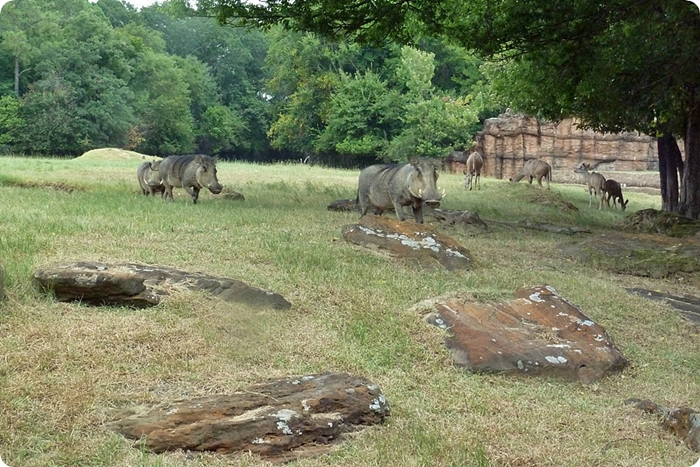
Common Warthogs (Phacochoerus africanus) and Greater Kudus (Tragelaphus strepsiceros)
Caldwell Zoo, Tyler, Texas, United States of America
Photo © Scott Richardson
Combined species:
- Common Warthog, Phacochoerus africanus
- Southern White Rhinoceros, Ceratotherium simum simum
Institution(s): Pairi Daiza (Brugelette, Belgium), Monde Sauvage Safari Parc (Aywaille, Belgium), Oasys MiniHollywood (Tabernas, Spain), Toronto Zoo (Ontario, Canada)
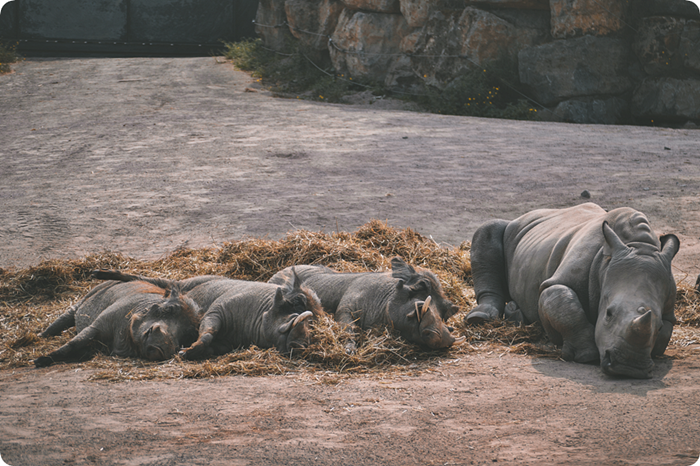
Common Warthogs (Phacochoerus africanus) and Southern White Rhinoceros (Ceratotherium simum simum)
Pairi Daiza, Brugelette, Belgium
Photo © Luis Fehrmann
Common Warthogs (Phacochoerus africanus) and Southern White Rhinoceroses (Ceratotherium simum simum)
Pairi Daiza, Brugelette, Belgium
Photo © Edward Breeze
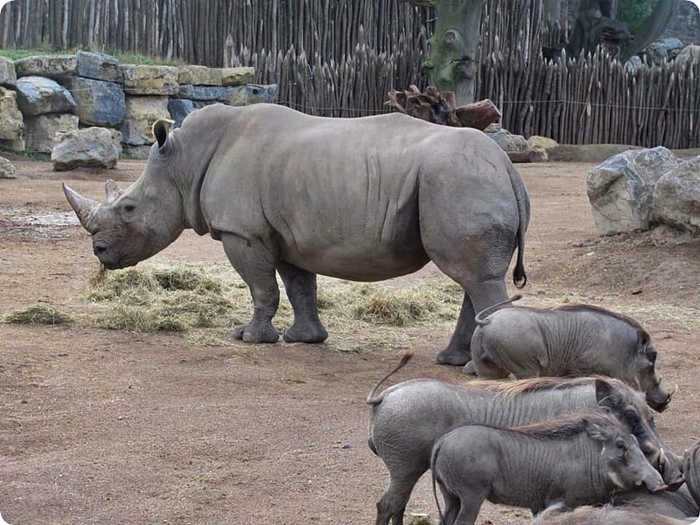
Common Warthogs (Phacochoerus africanus) and Southern White Rhinoceros (Ceratotherium simum simum)
Pairi Daiza, Brugelette, Belgium
Photo © Mario Berndtgen
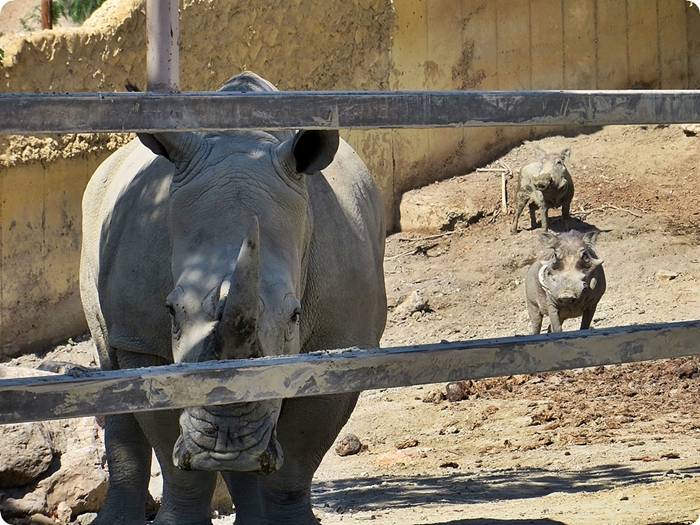
Common Warthogs (Phacochoerus africanus) and Southern White Rhinoceros (Ceratotherium simum simum)
Oasys MiniHollywood, Tabernas, Spain
Photo © Melody Cortés
Combined species:
- Common Warthog, Phacochoerus africanus
- Southern White Rhinoceros, Ceratotherium simum simum
- Nyala, Tragelaphus angasii
- Grey Crowned-crane, Balearica regulorum
Institution(s): Tulsa Zoo (Oklahoma, United States of America)
Common Warthog (Phacochoerus africanus) and Southern White Rhinoceros (Ceratotherium simum simum)
Tulsa Zoo, Oklahoma, United States of America
Photo © Tyler Butler
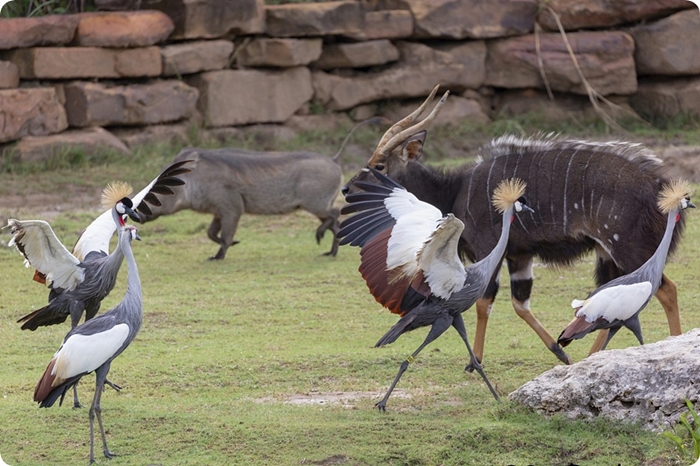
Common Warthog (Phacochoerus africanus), Nyala (Tragelaphus angasii) and Grey Crowned-cranes (Balearica regulorum)
Tulsa Zoo, Oklahoma, United States of America
Photo © Matt Thompson
Combined species:
- Common Warthog, Phacochoerus africanus
- Bushpig, Potamochoerus larvatus
- Cape Buffalo, Syncerus caffer
Institution(s): Uganda Wildlife Conservation Education Centre (Entebbe, Uganda)
Combined species:
- Common Warthog, Phacochoerus africanus
- Domestic Pig, Sus scrofa f. domestica
- Llama, Lama guanicoe f. glama
- Fallow Deer, Dama dama
- Common Eland, Tragelaphus oryx
- Domestic Cattle, Bos primigenius f. taurus
- Ankole-Watusi Cattle, Bos primigenius f. taurus
- Domestic Water Buffalo, Bubalus arnee f. bubalis
- Greater Rhea, Rhea americana
Institution(s): Virginia Safari Park (Natural Bridge, Virginia, United States of America)
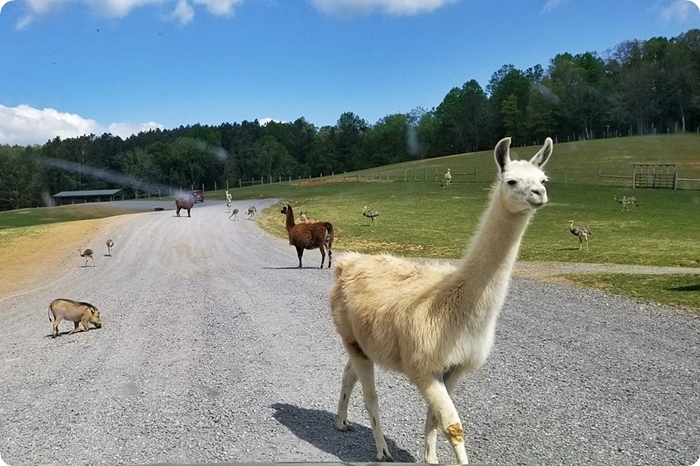
Common Warthog (Phacochoerus africanus) in a Drive-through Safari
Virginia Safari Park, Natural Bridge, Virginia, United States of America
Photo © Sarah Beaupre
Combined species:
- Common Warthog, Phacochoerus africanus
- Greater Kudu, Tragelaphus strepsiceros
- Common Eland, Tragelaphus oryx
- birds
Institution(s): ZooTampa at Lowry Park (Florida, United States of America)
Combined species:
- Common Warthog, Phacochoerus africanus
- Greater Kudu, Tragelaphus strepsiceros
- Rothschild's Giraffe, Giraffa camelopardalis rothschildi
- Ostrich, Struthio camelus
Institution(s): ZOO a zámek Zlín – Lešná (Czech Republic)
Common Warthogs (Phacochoerus africanus), Greater Kudus (Tragelaphus strepsiceros) and Rothschild's Giraffes (Giraffa camelopardalis rothschildi)
ZOO a zámek Zlín – Lešná, Czech Republic
Photo © Tamás Veress
Combined species:
- Common Warthog, Phacochoerus africanus
- Lesser Kudu, Tragelaphus imberbis
- Common Impala, Aepyceros melampus
- Thomson's Gazelle, Eudorcas thomsonii
- Common Wildebeest, Connochaetes taurinus
- Ostrich, Struthio camelus
- Saddle-billed Stork, Ephippiorhynchus senegalensis
- Pink-backed Pelican, Pelecanus rufescens
- Ruddy Shelduck, Tadorna ferruginea
- Rüppell's Vulture, Gyps rueppelli
- Lappet-faced Vulture, Torgos tracheliotos
- Crested Guineafowl, Guttera pucherani pucherani
- East African Grey Crowned-crane, Balearica regulorum gibbericeps
Institution(s): Cincinnati Zoo & Botanical Garden (Ohio, United States of America)
Combined species:
- Common Warthog, Phacochoerus africanus
- Mountain Bongo, Tragelaphus eurycerus isaaci
- Common Impala, Aepyceros melampus
Institution(s): BREC's Baton Rouge Zoo (Louisiana, United States of America)
Combined species:
- Common Warthog, Phacochoerus africanus
- Defassa Waterbuck, Kobus ellipsiprymnus defassa
- Ostrich, Struthio camelus
Institution(s): Brookfield Zoo (Illinois, United States of America)
Common Warthog (Phacochoerus africanus) and Defassa Waterbuck (Kobus ellipsiprymnus defassa)
Brookfield Zoo, Illinois, United States of America
Photo © www.zoochat.com
Combined species:
- Common Warthog, Phacochoerus africanus
- Uganda Kob, Kobus kob thomasi
- Defassa Waterbuck, Kobus ellipsiprymnus defassa
Institution(s): Uganda Wildlife Conservation Education Centre (Entebbe, Uganda)
Combined species:
- Common Warthog, Phacochoerus africanus
- Common Impala, Aepyceros melampus
- Springbok, Antidorcas marsupialis
- Common Wildebeest, Connochaetes taurinus
- Ostrich, Struthio camelus
Institution(s): North Carolina Zoo (Asheboro, North Carolina, United States of America)
Combined species:
- Common Warthog, Phacochoerus africanus
- Cuvier’s Gazelle, Gazella cuvieri
Institution(s): Saint Louis Zoo (Missouri, United States of America)
Combined species:
- Common Warthog, Phacochoerus africanus
- Slender-horned Gazelle, Gazella leptoceros
Institution(s): Sedgwick County Zoo (Wichita, Kansas, United States of America)
Combined species:
- Common Warthog, Phacochoerus africanus
- Zambian Sable Antelope, Hippotragus niger kirkii
Institution(s): San Diego Zoo (California, United States of America)
Common Warthog (Phacochoerus africanus) and Zambian Sable Antelopes (Hippotragus niger kirkii)
San Diego Zoo, California, United States of America
Photo © www.zoochat.com
Combined species:
- Common Warthog, Phacochoerus africanus
- African Forest Buffalo, Syncerus caffer nanus
Institution(s): Fővárosi Állat- és Növénykert (Budapest, Hungary), Zoo National du Mali (Bamako, Mali)
Common Warthog (Phacochoerus africanus) and African Forest Buffalo (Syncerus caffer nanus)
Fővárosi Állat- és Növénykert, Budapest, Hungary
Photos © Krisztián Svábik
Combined species:
- Common Warthog, Phacochoerus africanus
- Aoudad, Ammotragus lervia
Institution(s): Nyíregyházi Állatpark (Hungary)
Combined species:
- Common Warthog, Phacochoerus africanus
- Giraffe, Giraffa camelopardalis
Institution(s): San Diego Zoo (California, United States of America)
Combined species:
- Common Warthog, Phacochoerus africanus
- Reticulated and Rothschild's Giraffe, Giraffa camelopardalis reticulata/rothschildi
- Somali Ostrich, Struthio molybdophanes
Institution(s): Oklahoma City Zoo (Oklahoma, United States of America)
Combined species:
- Common Warthog, Phacochoerus africanus
- African Spurred Tortoise, Centrochelys sulcata
Institution(s): Fresno Chaffee Zoo (California, United States of America)
 Giant Forest Hog, Hylochoerus meinertzhageni
Giant Forest Hog, Hylochoerus meinertzhageni
Combined species:
- Giant Forest Hog, Hylochoerus meinertzhageni
- Bush Duiker, Sylvicapra grimmia
- Kirk's Dik-dik, Madoqua kirkii
Institution(s): Nairobi Safari Walk (Kenya)
Combined species:
- Giant Forest Hog, Hylochoerus meinertzhageni meinertzhageni
- Bush Duiker, Sylvicapra grimmia
- Bushbuck, Tragelaphus scriptus
- Bohor Reedbuck, Redunca redunca
- Uganda Kob, Kobus kob thomasi
- Defassa Waterbuck, Kobus ellipsiprymnus defassa
- Egyptian Goose, Alopochen aegyptiaca
Institution(s): Uganda Wildlife Conservation Education Centre (Entebbe, Uganda)
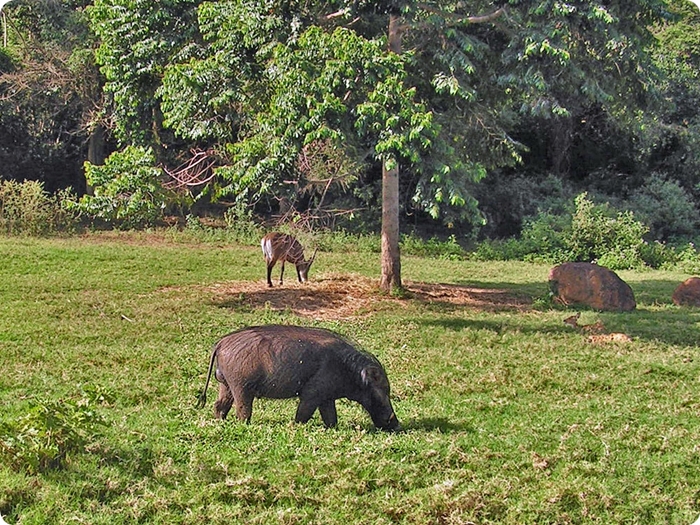
Giant Forest Hog (Hylochoerus meinertzhageni meinertzhageni) and Uganda Kob (Kobus kob thomasi)
Uganda Wildlife Conservation Education Centre, Entebbe, Uganda
Photo © Dr. Peter Dollinger
Giant Forest Hogs (Hylochoerus meinertzhageni meinertzhageni) and Egyptian Goose (Alopochen aegyptiaca)
Uganda Wildlife Conservation Education Centre, Entebbe, Uganda
Photo © Nick Hadad
 Bushpig, Potamochoerus larvatus
Bushpig, Potamochoerus larvatus
Combined species:
- Bushpig, Potamochoerus larvatus
- Common Warthog, Phacochoerus africanus
- Cape Buffalo, Syncerus caffer
Institution(s): Uganda Wildlife Conservation Education Centre (Entebbe, Uganda)
Combined species:
- Bushpig, Potamochoerus larvatus
- Red River Hog, Potamochoerus porcus
Institution(s): Cango Wildlife Ranch (Oudtshoorn, South Africa)
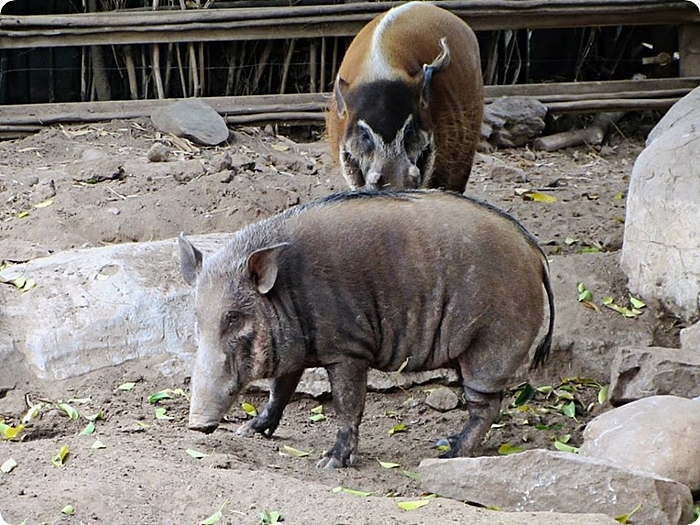
Bushpig (Potamochoerus larvatus) and Red River Hog (Potamochoerus porcus)
Cango Wildlife Ranch, Oudtshoorn, South Africa
Photo © Quentin Vanhoose
Bushpig (Potamochoerus larvatus) and Red River Hog (Potamochoerus porcus) mixed exhibit
Cango Wildlife Ranch, Oudtshoorn, South Africa
Photo © Quentin Vanhoose
Red River Hog, Potamochoerus porcus
Combined species:
- Red River Hog, Potamochoerus porcus
- Rock Hyrax, Procavia capensis
- De Brazza’s Monkey, Cercopithecus neglectus
- Guereza, Colobus guereza
Institution(s): Minnesota Zoo (Minnesota, United States of America)
Red River Hogs (Potamochoerus porcus) and De Brazza’s Monkey (Cercopithecus neglectus)
Minnesota Zoo, Minnesota, United States of America
Photo © Scott Richardson
Red River Hog (Potamochoerus porcus) and Guereza (Colobus guereza)
Minnesota Zoo, Minnesota, United States of America
Photo © Alex Kantorovich
Combined species:
- Red River Hog, Potamochoerus porcus
- African Elephant, Loxodonta africana
- Domestic Cat, Felis catus
Institution(s): Ouwehands Dierenpark (Rhenen, the Netherlands)
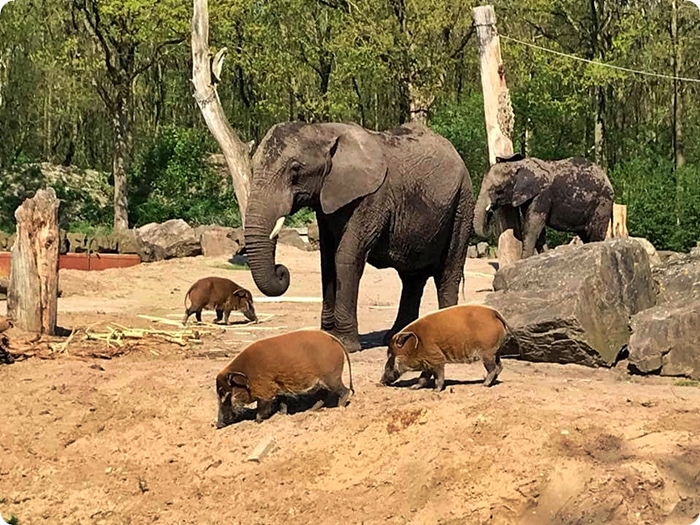
Red River Hogs (Potamochoerus porcus) and African Elephants (Loxodonta africana)
Ouwehands Dierenpark, Rhenen, the Netherlands
Photo © Mario Berndtgen
Red River Hog (Potamochoerus porcus) and African Elephant (Loxodonta africana)
Ouwehands Dierenpark, Rhenen, the Netherlands
Photo © Bjorn Krebbers
Red River Hog (Potamochoerus porcus) and African Elephant (Loxodonta africana)
Ouwehands Dierenpark, Rhenen, the Netherlands
Photo © Alex Kantorovich
Combined species:
- Red River Hog, Potamochoerus porcus
- White-naped Mangabey, Cercocebus atys lunulatus
Institution(s): Zoo Salzburg Hellbrunn (Austria)
Red River Hogs (Potamochoerus porcus) and White-naped Mangabeys (Cercocebus atys lunulatus)
Zoo Salzburg Hellbrunn, Austria
Photo © www.zoochat.com
Combined species:
- Red River Hog, Potamochoerus porcus
- Diana Monkey, Cercopithecus diana
Institution(s): Zoo Salzburg Hellbrunn (Austria)
Combined species:
- Red River Hog, Potamochoerus porcus
- Guereza, Colobus guereza
Institution(s): Peoria Zoo (Illinois, United States of America)
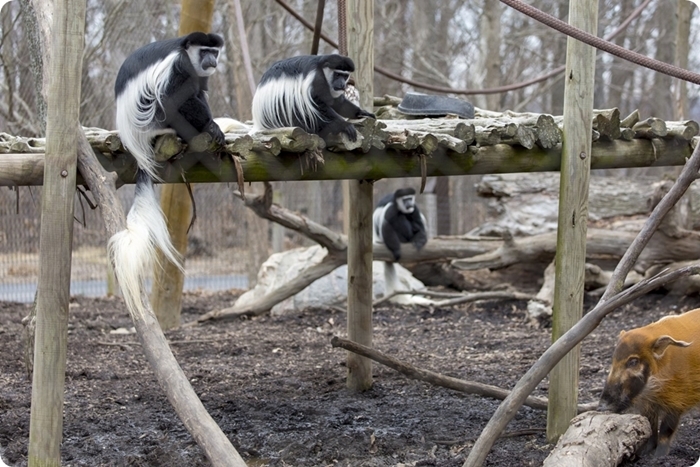
Red River Hog (Potamochoerus porcus) and Guerezas (Colobus guereza)
Peoria Zoo, Illinois, United States of America
Photo © Matt Thompson
Red River Hog (Potamochoerus porcus) and Guereza (Colobus guereza) mixed exhibit
Peoria Zoo, Illinois, United States of America
Photo © www.zoochat.com
Combined species:
- Red River Hog, Potamochoerus porcus
- De Brazza’s Monkey, Cercopithecus neglectus
Institution(s): Bronx Zoo (New York, United States of America)
Combined species:
- Red River Hog, Potamochoerus porcus
- Mandrill, Mandrillus sphinx
Institution(s): Bronx Zoo (New York, United States of America)
Red River Hog (Potamochoerus porcus) and Mandrill (Mandrillus sphinx)
Bronx Zoo, New York, United States of America
Photo © T. Santiago-Gamble
Red River Hog (Potamochoerus porcus) and Mandrill (Mandrillus sphinx)
Bronx Zoo, New York, United States of America
Photo © Marc Fishkind
Combined species:
- Red River Hog, Potamochoerus porcus
- De Brazza’s Monkey, Cercopithecus neglectus
- Mandrill, Mandrillus sphinx
Institution(s): Bronx Zoo (New York, United States of America)
Combined species:
- Red River Hog, Potamochoerus porcus
- De Brazza’s Monkey, Cercopithecus neglectus
- Spotted-necked Otter, Hydrictis maculicollis
- African Forest Buffalo, Syncerus caffer nanus
Institution(s): San Diego Zoo (California, United States of America)
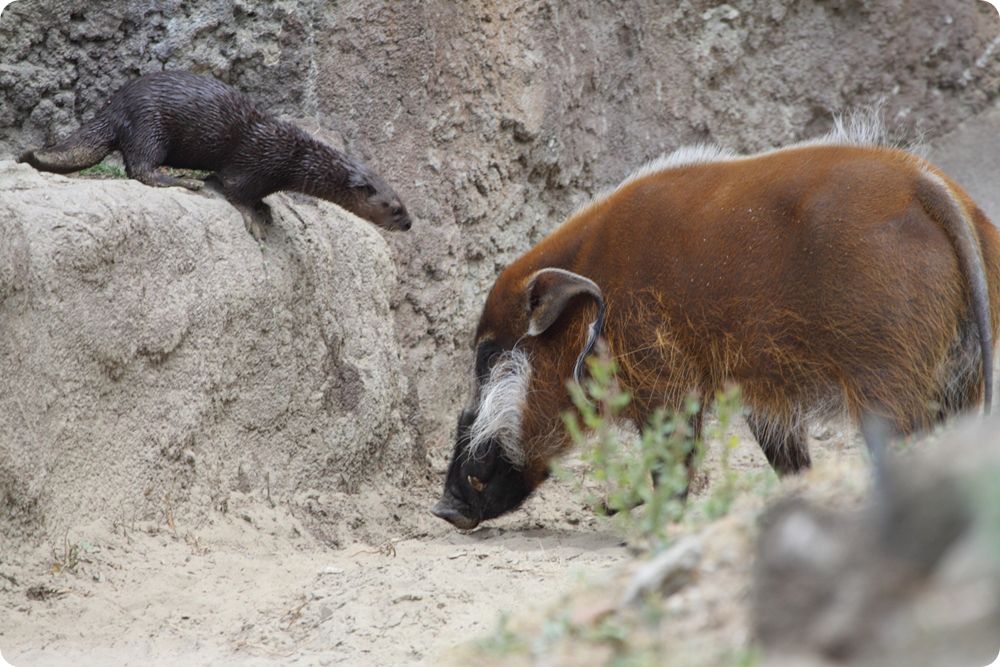
Red River Hog (Potamochoerus porcus) and Spotted-necked Otter (Hydrictis maculicollis)
San Diego Zoo, California, United States of America
Photo © Brent Huffman
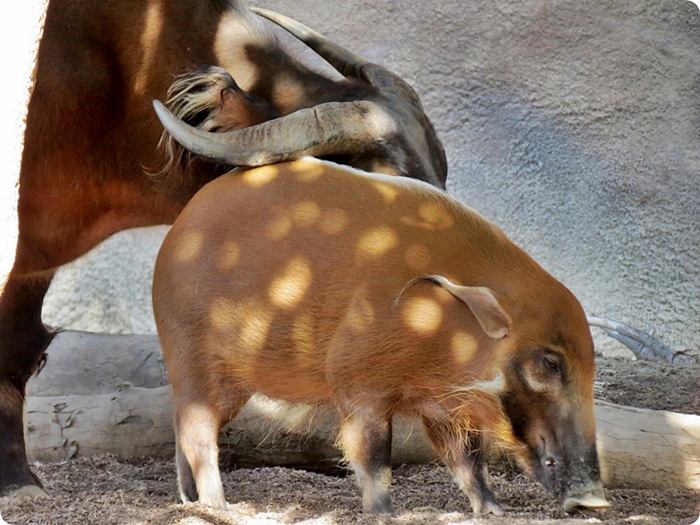
Red River Hog (Potamochoerus porcus) and African Forest Buffalo (Syncerus caffer nanus)
San Diego Zoo, California, United States of America
Photo © David Freely
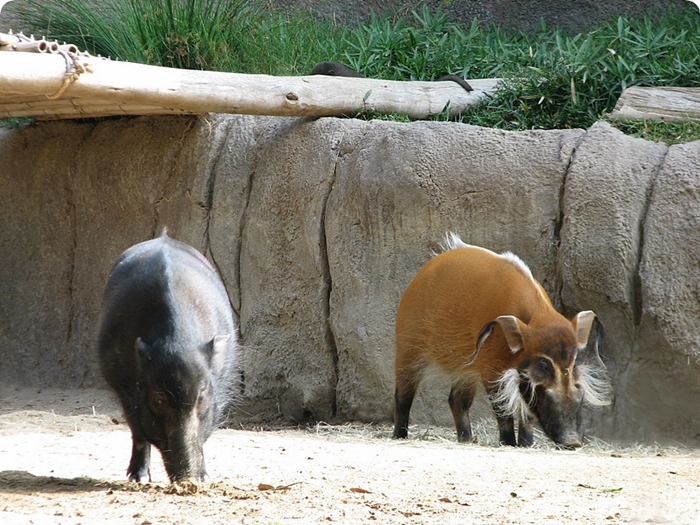
A normally coloured Red River Hog (Potamochoerus porcus) on the right and probably a melanistic Red River Hog or Bushpig on the left, which was previously thought to be a Giant Forest Hog
San Diego Zoo, California, United States of America
Photo © David Freely
Combined species:
- Red River Hog, Potamochoerus porcus
- Western Lowland Gorilla, Gorilla gorilla gorilla
Institution(s): Houston Zoo (Texas, United States of America)
*Combined species:
- Red River Hog, Potamochoerus porcus
- Bonobo, Pan paniscus
Institution(s): Columbus Zoo and Aquarium (Ohio, United States of America)
*Animals not always exhibited together
Combined species:
- Red River Hog, Potamochoerus porcus
- Meerkat, Suricata suricatta
Institution(s): Pairi Daiza (Brugelette, Belgium)
Combined species:
- Red River Hog, Potamochoerus porcus
- Yellow Mongoose, Cynictis penicillata
Institution(s): Chester Zoo (United Kingdom)
Red River Hogs (Potamochoerus porcus) and Yellow Mongoose (Cynictis penicillata)
Chester Zoo, United Kingdom
Photo © Krisztián Svábik
Combined species:
- Red River Hog, Potamochoerus porcus
- Banded Mongoose, Mungos mungo
Institution(s): Safaripark Beekse Bergen (Hilvarenbeek, the Netherlands)
Red River Hog (Potamochoerus porcus) and Banded Mongooses (Mungos mungo)
Safaripark Beekse Bergen, Hilvarenbeek, the Netherlands
Photo © Örs Görög
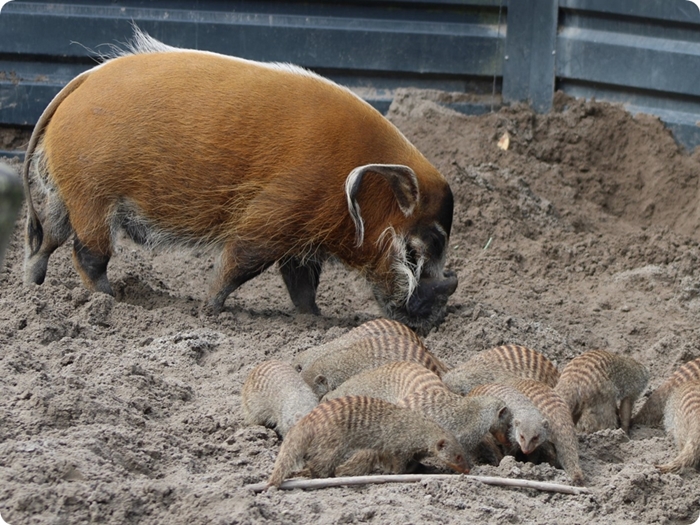
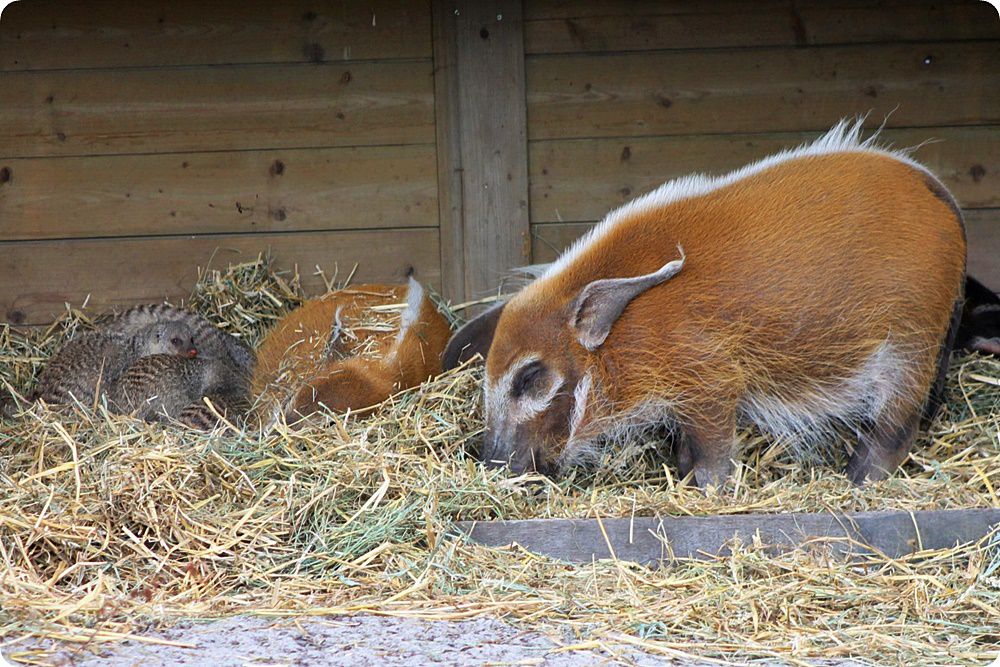
Red River Hogs (Potamochoerus porcus) and Banded Mongooses (Mungos mungo)
Safaripark Beekse Bergen, Hilvarenbeek, the Netherlands
Photos © Maarten de Ruiter
Combined species:
- Red River Hog, Potamochoerus porcus
- Bat-eared Fox, Otocyon megalotis
- Egyptian Goose, Alopochen aegyptiaca
Institution(s): Saint Louis Zoo (Missouri, United States of America)
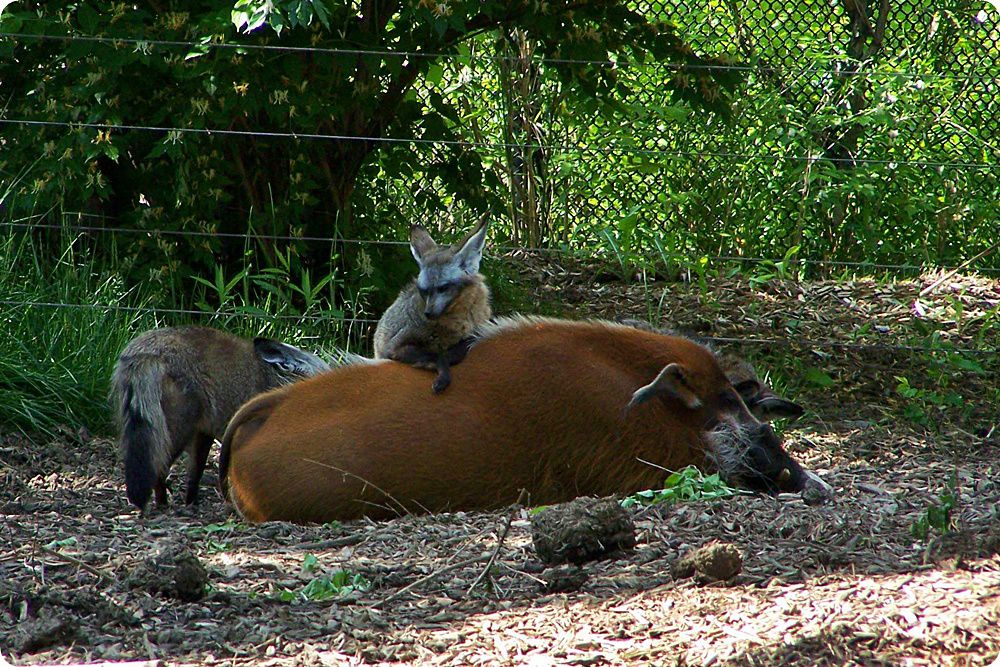
Red River Hog (Potamochoerus porcus) and Bat-eared Foxes (Otocyon megalotis)
Saint Louis Zoo, Missouri, United States of America
Photo © Saint Louis Zoo
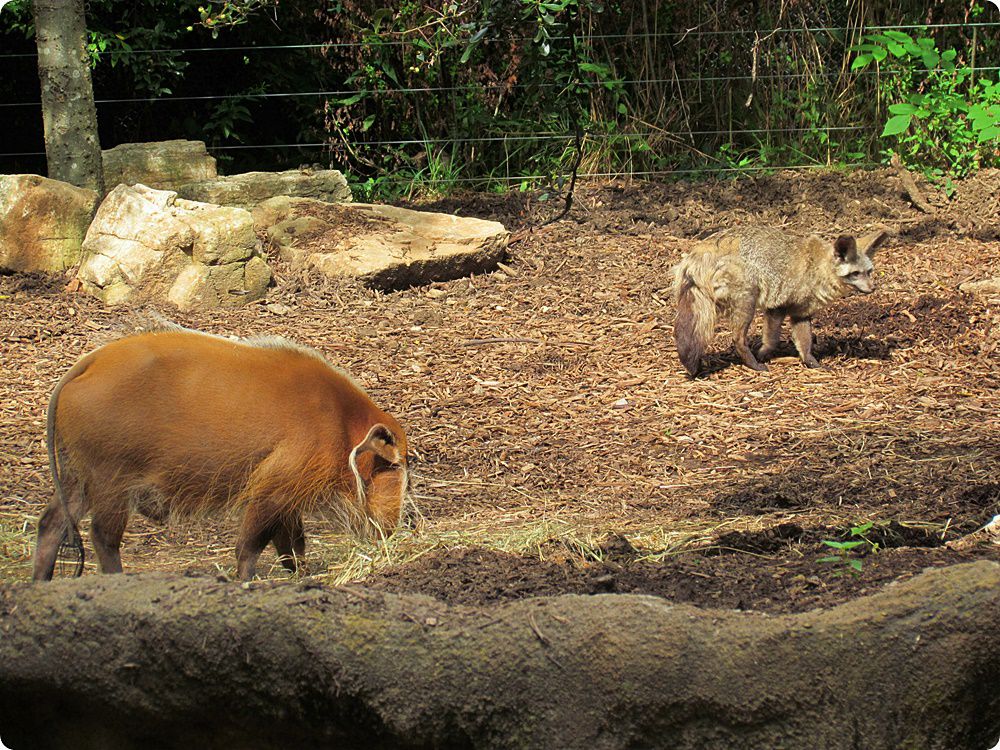
Red River Hog (Potamochoerus porcus) and Bat-eared Fox (Otocyon megalotis)
Saint Louis Zoo, Missouri, United States of America
Photo © Thomas Bauer
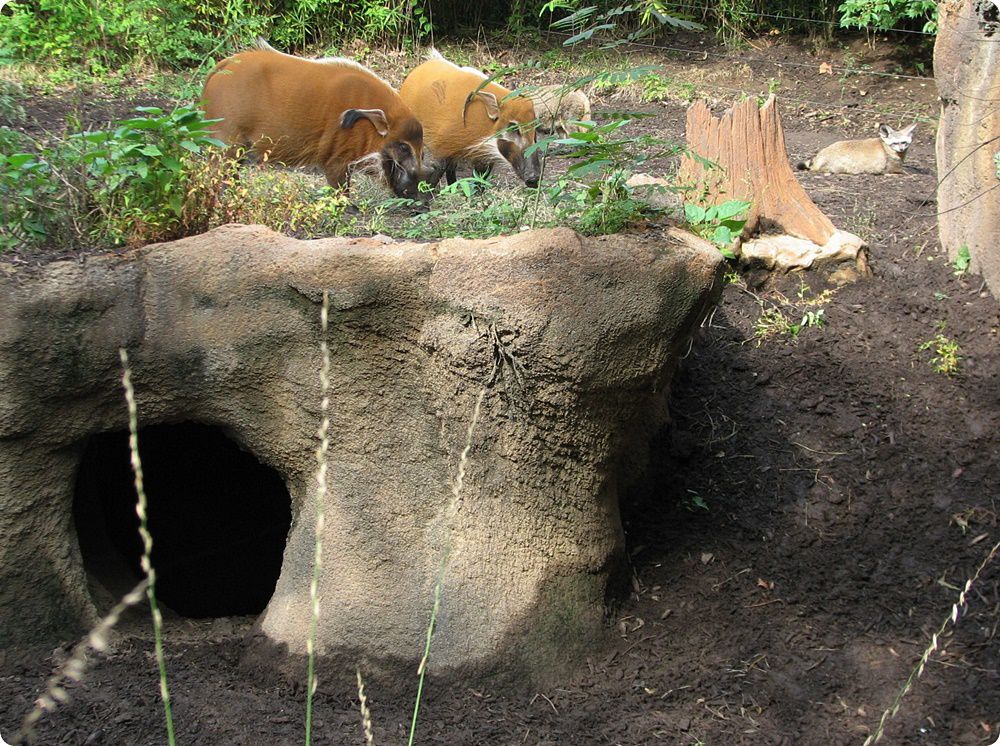
Red River Hogs (Potamochoerus porcus) and Bat-eared Foxes (Otocyon megalotis)
Saint Louis Zoo, Missouri, United States of America
Photo © David Freely
Combined species:
- Red River Hog, Potamochoerus porcus
- Burchell's Zebra, Equus quagga burchellii
- Ankole-Watusi Cattle, Bos primigenius f. taurus
Institution(s): Zoo Duisburg (Germany)
Combined species:
- Red River Hog, Potamochoerus porcus
- Chapman's Zebra, Equus quagga chapmani
- Southern White Rhinoceros, Ceratotherium simum simum
Institution(s): Zoo Osnabrück (Germany)
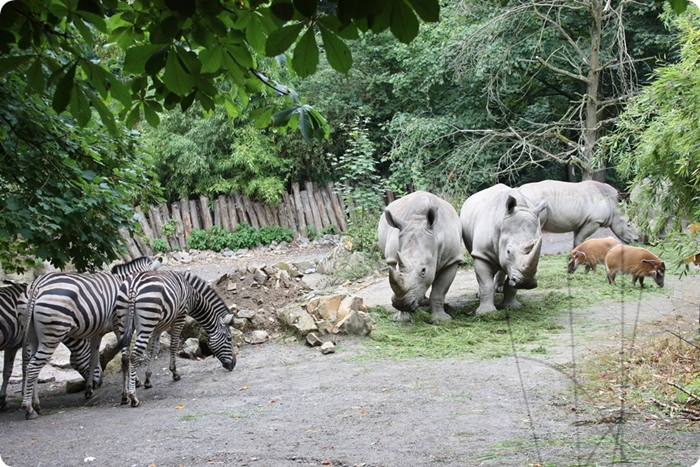
Red River Hogs (Potamochoerus porcus), Chapman's Zebras (Equus quagga chapmani) and Southern White Rhinoceroses (Ceratotherium simum simum)
Zoo Osnabrück, Germany
Photo © Katja Lammers
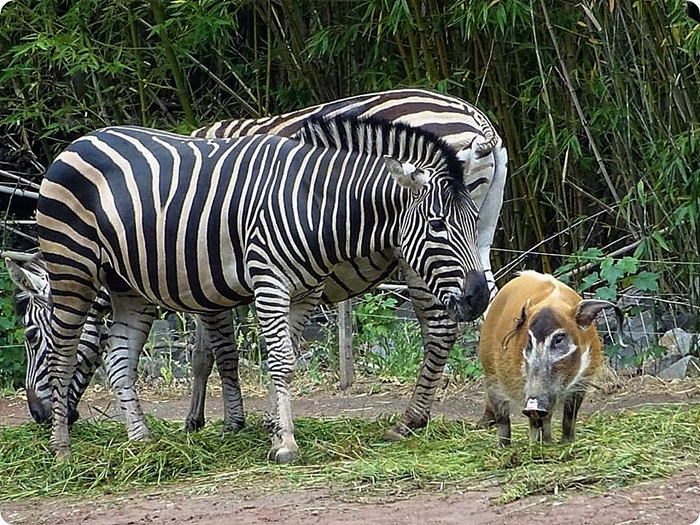
Red River Hog (Potamochoerus porcus) and Chapman's Zebras (Equus quagga chapmani)
Zoo Osnabrück, Germany
Photo © Christian Driesen
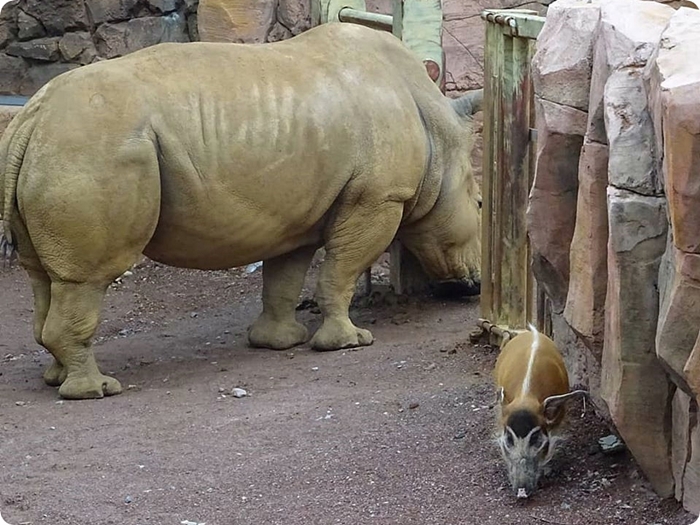
Red River Hog (Potamochoerus porcus) and Southern White Rhinoceros (Ceratotherium simum simum)
Zoo Osnabrück, Germany
Photo © Christian Driesen
Combined species:
- Red River Hog, Potamochoerus porcus
- Grant’s Zebra, Equus quagga boehmi
- Southern White Rhinoceros, Ceratotherium simum simum
- Defassa Waterbuck, Kobus ellipsiprymnus defassa
- Common Impala, Aepyceros melampus
- Common Wildebeest, Connochaetes taurinus
- Rothschild's Giraffe, Giraffa camelopardalis rothschildi
- Ostrich, Struthio camelus
Institution(s): WILDLANDS Adventure Zoo Emmen (the Netherlands)
Combined species:
- Red River Hog, Potamochoerus porcus
- Grant’s Zebra, Equus quagga boehmi
- Southern White Rhinoceros, Ceratotherium simum simum
- Defassa Waterbuck, Kobus ellipsiprymnus defassa
- Common Impala, Aepyceros melampus
- Common Wildebeest, Connochaetes taurinus
- Rothschild's Giraffe, Giraffa camelopardalis rothschildi
- Ostrich, Struthio camelus
- Helmeted Guineafowl, Numida meleagris
- Crowned-crane, Balearica sp.
Institution(s): Noorder Dierenpark (Emmen, the Netherlands)
Red River Hogs (Potamochoerus porcus), Grant’s Zebras (Equus quagga boehmi), Southern White Rhinoceroses (Ceratotherium simum simum), Common Impalas (Aepyceros melampus) and Rothschild's Giraffes (Giraffa camelopardalis rothschildi) in a Savanna exhibit
Noorder Dierenpark, Emmen, the Netherlands
Photo © Erik Roels
Combined species:
- Red River Hog, Potamochoerus porcus
- Plains Zebra, Equus quagga
- Common Impala, Aepyceros melampus
- Thomson’s Gazelle, Eudorcas thomsonii
- Waterbuck, Kobus ellipsiprymnus
- Roan Antelope, Hippotragus equinus
- Common Wildebeest, Connochaetes taurinus
- Reticulated Giraffe, Giraffa camelopardalis reticulata
- Egyptian Goose, Alopochen aegyptiaca
- East African Grey Crowned Crane, Balearica regulorum gibbericeps
Institution(s): Disney's Animal Kingdom Lodge (Orlando, Florida, United States of America)
Combined species:
- Red River Hog, Potamochoerus porcus
- Southern White Rhinoceros, Ceratotherium simum simum
- Marabou, Leptoptilos crumenifer
Institution(s): Zoo de Granby (Quebec, Canada)
Combined species:
- Red River Hog, Potamochoerus porcus
- Eastern Black Rhinoceros, Diceros bicornis michaeli
- Greater Kudu, Tragelaphus strepsiceros
- East African Sitatunga, Tragelaphus spekii spekii
- Ugandan Kob, Kobus kob thomasi
- Angolan Roan Antelope, Hippotragus equinus cottoni
- White-bearded Wildebeest, Connochaetes taurinus albojubatus
- Ankole-Watusi Cattle, Bos primigenius f. taurus
Institutiuon(s): San Diego Zoo Safari Park (Escondido, California, United States of America)
Combined species:
- Red River Hog, Potamochoerus porcus
- Bushpig, Potamochoerus larvatus
Institution(s): Cango Wildlife Ranch (Oudtshoorn, South Africa)
Combined species:
- Red River Hog, Potamochoerus porcus
- Hippopotamus, Hippopotamus amphibius
Institution(s): Zoo du Bassin d’Arcachon (La Teste-de-Buch, France)
Combined species:
- Red River Hog, Potamochoerus porcus
- Pygmy Hippopotamus, Choeropsis liberiensis
- Nile Lechwe, Kobus megaceros
- Domestic Helmeted Guineafowl, Numida meleagris f. domestica
Institution(s): Szegedi Vadaspark (Hungary)
Combined species:
- Red River Hog, Potamochoerus porcus
- Pygmy Hippopotamus, Choeropsis liberiensis
- Addax, Addax nasomaculatus
- Domestic Helmeted Guineafowl, Numida meleagris f. domestica
Institution(s): Szegedi Vadaspark (Hungary)
Combined species:
- Red River Hog, Potamochoerus porcus
- Addax, Addax nasomaculatus
- Domestic Helmeted Guineafowl, Numida meleagris f. domestica
Institution(s): Szegedi Vadaspark (Hungary)
Combined species:
- Red River Hog, Potamochoerus porcus
- Mountain Bongo, Tragelaphus eurycerus isaaci
Institution(s): Los Angeles Zoo (California, United States of America), Sacramento Zoo (California, United States of America), Franklin Park Zoo (Boston, Massachusetts, United States of America), BREC's Baton Rouge Zoo (Louisiana, United States of America), RZSS Edinburgh Zoo (United Kingdom), GaiaZOO (Kerkrade, the Netherlands)
Red River Hog (Potamochoerus porcus) and Mountain Bongo (Tragelaphus eurycerus isaaci)
RZSS Edinburgh Zoo, United Kingdom
Photo © Christopher McLaughlan
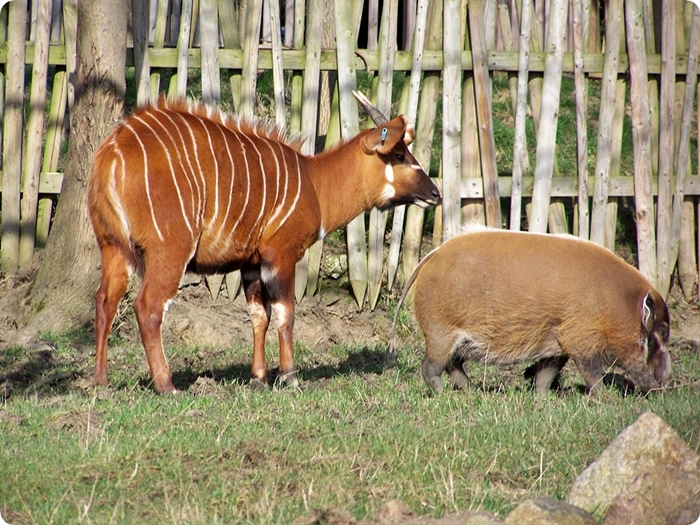
Red River Hog (Potamochoerus porcus) and Mountain Bongo (Tragelaphus eurycerus isaaci)
RZSS Edinburgh Zoo, United Kingdom
Photo © www.zoochat.com
Combined species:
- Red River Hog, Potamochoerus porcus
- Mountain Bongo, Tragelaphus eurycerus isaaci
- Common Impala, Aepyceros melampus
- Pink-backed Pelican, Pelecanus rufescens
Institution(s): Zoo Osnabrück (Germany)
Combined species:
- Red River Hog, Potamochoerus porcus
- Sitatunga, Tragelaphus spekii
Institution(s): Smithsonian National Zoological Park (Washington, DC, United States of America), Africa Alive! (Kessingland, United Kingdom)
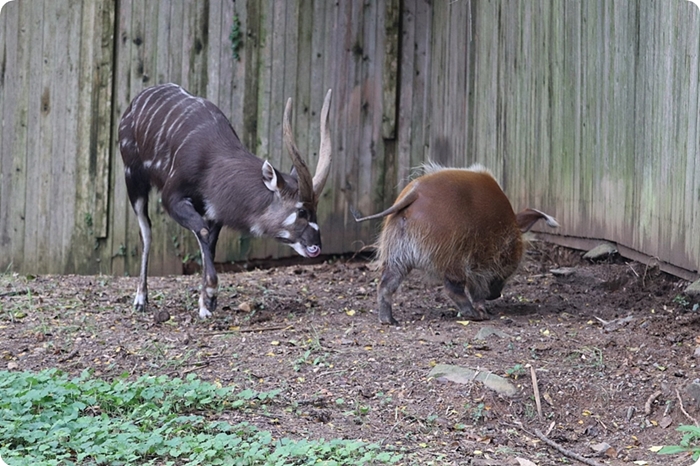
Red River Hog (Potamochoerus porcus) and Sitatunga (Tragelaphus spekii)
Smithsonian National Zoological Park, Washington, DC, United States of America
Photo © Andrew Hyman
Combined species:
- Red River Hog, Potamochoerus porcus
- Nyala, Tragelaphus angasii
Institution(s): Dallas Zoo (Texas, United States of America)
Combined species:
- Red River Hog, Potamochoerus porcus
- Mountain Bongo, Tragelaphus eurycerus isaaci
- Thomson’s Gazelle, Eudorcas thomsonii
- Waterbuck, Kobus ellipsiprymnus
- Ankole-Watusi Cattle, Bos primigenius f. taurus
- Reticulated/Rothschild’s Giraffe Hybrid, Giraffa camelopardalis reticulata/rothschildi
- Ostrich, Struthio camelus
Institution(s): Disney's Animal Kingdom Lodge (Orlando, Florida, United States of America)
Combined species:
- Red River Hog, Potamochoerus porcus
- Nyala, Tragelaphus angasii
- Grant's Gazelle, Nanger granti
- Waterbuck, Kobus ellipsiprymnus
- Ankole-Watusi Cattle, Bos primigenius f. taurus
- Giraffe, Giraffa camelopardalis
- Ostrich, Struthio camelus
- Marabou, Leptoptilos crumenifer
- Rüppell's Vulture, Gyps rueppelli
- Black Crowned-crane, Balearica pavonina
- Abyssinian Ground-hornbill, Bucorvus abyssinicus
Institution(s): Disney's Animal Kingdom Lodge (Orlando, Florida, United States of America)
Combined species:
- Red River Hog, Potamochoerus porcus
- Nyala, Tragelaphus angasii
- Common Impala, Aepyceros melampus
- Waterbuck, Kobus ellipsiprymnus
- Steenbok, Raphicerus campestris
- Thomson’s Gazelle, Eudorcas thomsonii
- Ankole-Watusi Cattle, Bos primigenius f. taurus
- Okapi, Okapia johnstoni
- Egyptian Goose, Alopochen aegyptiaca
- Spur-winged Goose, Plectropterus gambensis
- Rüppell’s Vulture, Gyps rueppellii
- East African Grey Crowned Crane, Balaerica regulorum gibbericeps
- Blue Crane, Anthropoides paradiseus
- Wattled Crane, Bugeranus carunculatus
- Abyssinian Ground-hornbill, Bucorvus abyssinicus
Institution(s): Disney's Animal Kingdom Lodge (Orlando, Florida, United States of America)
Combined species:
- Red River Hog, Potamochoerus porcus
- Defassa Waterbuck, Kobus ellipsiprymnus defassa
- Ostrich, Struthio camelus
Institution(s): Brookfield Zoo (Illinois, United States of America)
Red River Hogs (Potamochoerus porcus) and Defassa Waterbucks (Kobus ellipsiprymnus defassa)
Brookfield Zoo, Illinois, United States of America
Photo © www.zoochat.com
Combined species:
- Red River Hog, Potamochoerus porcus
- Waterbuck, Kobus ellipsiprymnus
- African Forest Buffalo, Syncerus caffer nanus
Institution(s): Zoo Aquarium de Madrid (Spain)
Combined species:
- Red River Hog, Potamochoerus porcus
- African Forest Buffalo, Syncerus caffer nanus
Institution(s): Zoo Aquarium de Madrid (Spain), Diergaarde Blijdorp (Rotterdam, the Netherlands), Tierpark Berlin (Germany), San Diego Zoo (California, United States of America)
Red River Hogs (Potamochoerus porcus) and African Forest Buffaloes (Syncerus caffer nanus)
Tierpark Berlin, Germany
Photo © www.zoochat.com
Combined species:
- Red River Hog, Potamochoerus porcus
- African Forest Buffalo, Syncerus caffer nanus
- Great White Pelican, Pelecanus onocrotalus
Institution(s): Bioparc Valencia (Spain)
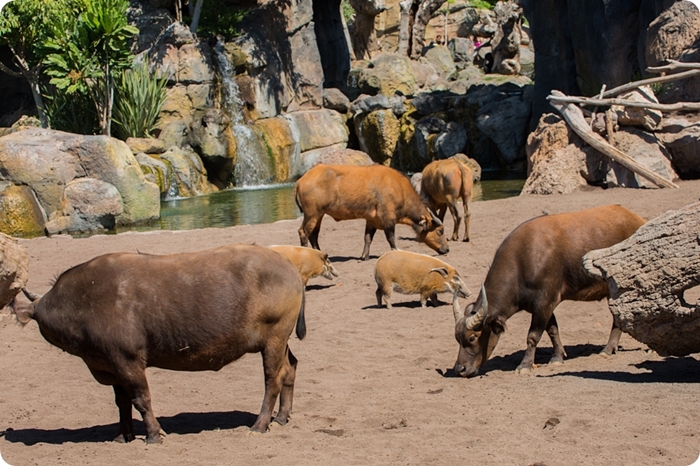
Red River Hogs (Potamochoerus porcus) and African Forest Buffaloes (Syncerus caffer nanus)
Bioparc Valencia, Spain
Photo © Jamie Lucas
Red River Hogs (Potamochoerus porcus) and African Forest Buffaloes (Syncerus caffer nanus)
Bioparc Valencia, Spain
Photo © Ben Gilbert
Red River Hog (Potamochoerus porcus), African Forest Buffalo (Syncerus caffer nanus) and Great White Pelican (Pelecanus onocrotalus) mixed exhibit
Bioparc Valencia, Spain
Photo © Alan Torres Dwyer
Combined species:
- Red River Hog, Potamochoerus porcus
- Ankole-Watusi Cattle, Bos primigenius f. taurus
Institution(s): Zoo Duisburg (Germany), Zoo Landau in der Pfalz (Germany)
Red River Hogs (Potamochoerus porcus) and Ankole-Watusi Cattles (Bos primigenius f. taurus)
Zoo Duisburg, Germany
Photo © Allan Galway
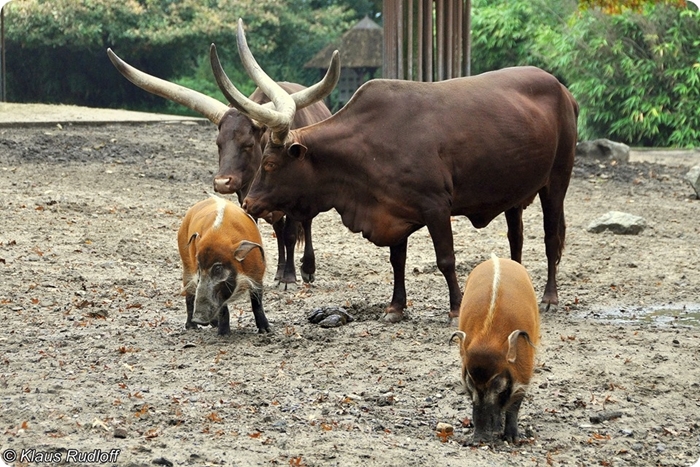
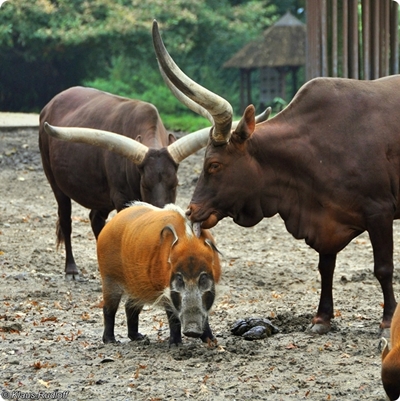
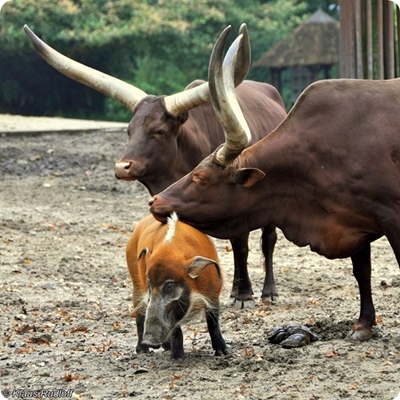
Red River Hogs (Potamochoerus porcus) and Ankole-Watusi Cattles (Bos primigenius f. taurus)
Zoo Duisburg, Germany
Photos © Klaus Rudloff
Combined species:
- Red River Hog, Potamochoerus porcus
- Mhorr Gazelle, Nanger dama mhorr
- White Stork, Ciconia ciconia
- Saddle-billed Stork, Ephippiorhynchus senegalensis
Institution(s): Philadelphia Zoo (Pennsylvania, United States of America)
Combined species:
- Red River Hog, Potamochoerus porcus
- Reticulated Giraffe, Giraffa camelopardalis reticulata
Institution(s): Wild Place Project (Bristol, United Kingdom)
Combined species:
- Red River Hog, Potamochoerus porcus
- Helmeted Guineafowl, Numida meleagris
Institution(s): Wild Place Project (Bristol, United Kingdom)
Visayan Warty Pig, Sus cebifrons negrinus
Combined species:
- Visayan Warty Pig, Sus cebifrons negrinus
- Greater One-horned Rhinoceros, Rhinoceros unicornis
Institution(s): ZOO Planckendael (Mechelen, Belgium), Diergaarde Blijdorp (Rotterdam, the Netherlands)
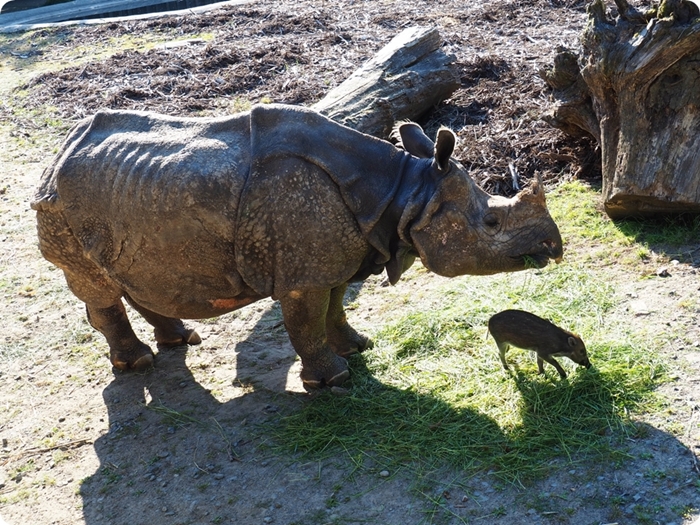
Visayan Warty Pig (Sus cebifrons negrinus) and Greater One-horned Rhinoceros (Rhinoceros unicornis)
ZOO Planckendael, Mechelen, Belgium
Photo © Kevin B.
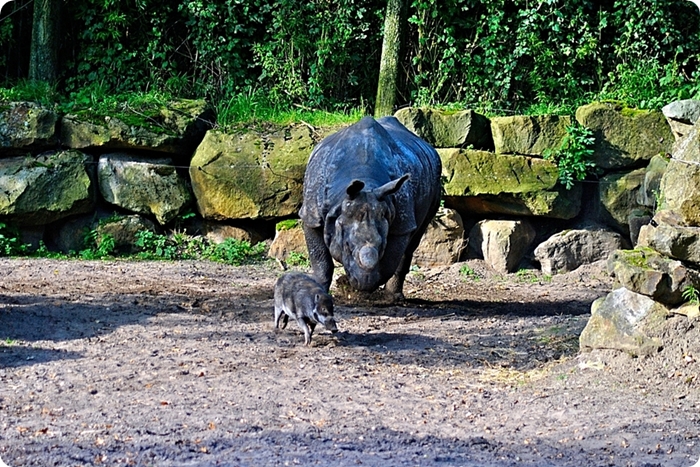
Visayan Warty Pig (Sus cebifrons negrinus) and Greater One-horned Rhinoceros (Rhinoceros unicornis)
Diergaarde Blijdorp, Rotterdam, the Netherlands
Photo © Tim Sagorski
Combined species:
- Visayan Warty Pig, Sus cebifrons negrinus
- Asian Small-clawed Otter, Aonyx cinereus
- Greater One-horned Rhinoceros, Rhinoceros unicornis
- Reeves’ Muntjac, Muntiacus reevesi
Institution(s): Zoo Basel (Switzerland)
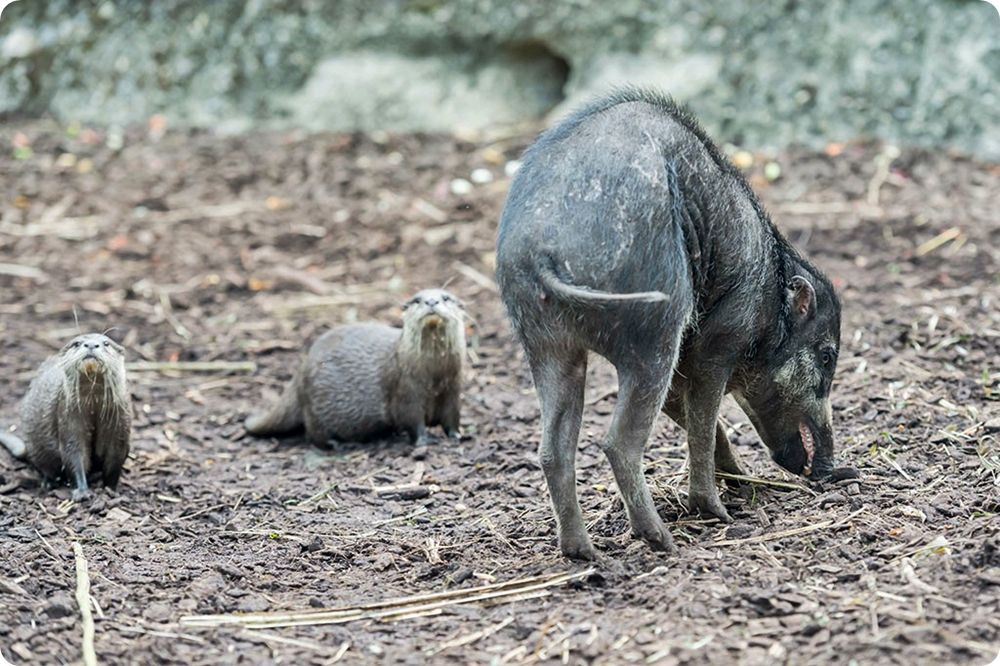
Visayan Warty Pig (Sus cebifrons negrinus) and Asian Small-clawed Otters (Aonyx cinereus)
Zoo Basel, Switzerland
Photo © Zoo Basel
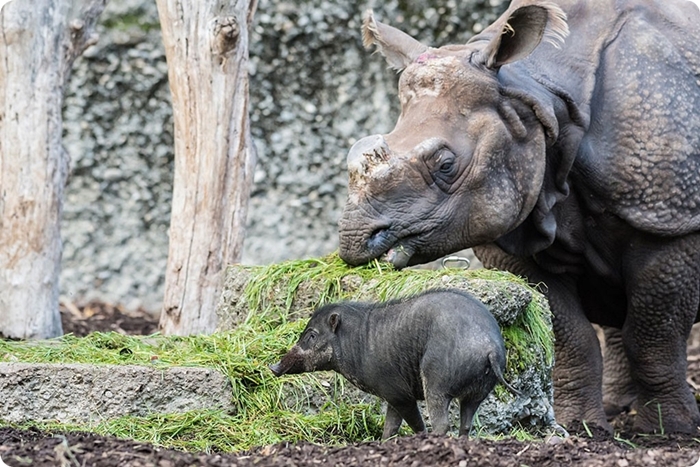
Visayan Warty Pig (Sus cebifrons negrinus) and Greater One-horned Rhinoceros (Rhinoceros unicornis)
Zoo Basel, Switzerland
Photo © Zoo Basel
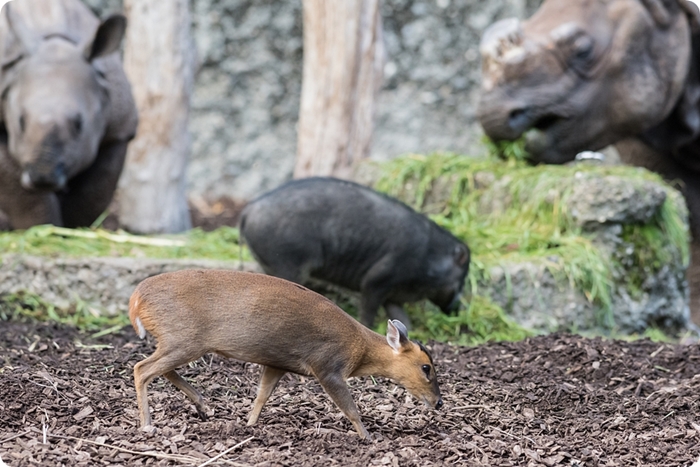
Visayan Warty Pig (Sus cebifrons negrinus), Greater One-horned Rhinoceroses (Rhinoceros unicornis) and Reeves’ Muntjac (Muntiacus reevesi)
Zoo Basel, Switzerland
Photo © Zoo Basel
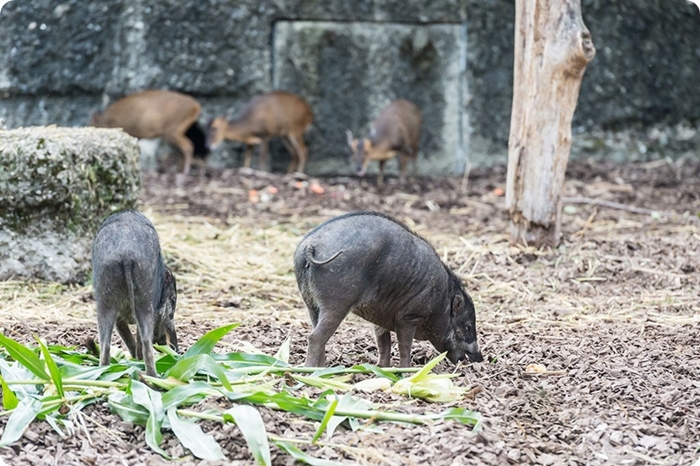
Visayan Warty Pigs (Sus cebifrons negrinus) and Reeves’ Muntjacs (Muntiacus reevesi)
Zoo Basel, Switzerland
Photo © Zoo Basel
Combined species:
- Visayan Warty Pig, Sus cebifrons negrinus
- Greater One-horned Rhinoceros, Rhinoceros unicornis
- Nilgai, Boselaphus tragocamelus
- Hog Deer, Axis porcinus porcinus
Institution(s): Dierenrijk (Mierlo, the Netherlands)
Combined species:
- Visayan Warty Pig, Sus cebifrons negrinus
- Malayan Tapir, Tapirus indicus
Institution(s): San Diego Zoo (California, United States of America), ZooTampa at Lowry Park (Florida, United States of America)
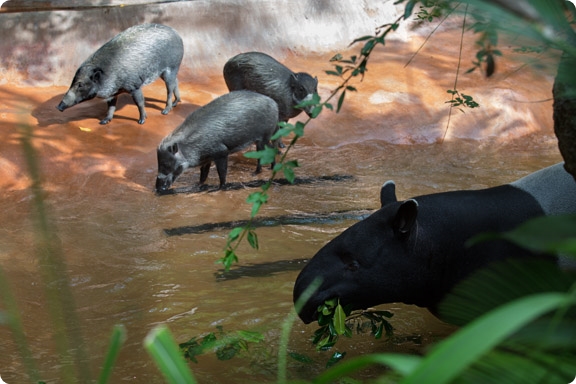
Visayan Warty Pigs (Sus cebifrons negrinus) and Malayan Tapir (Tapirus indicus)
San Diego Zoo, California, United States of America
Photo © Fred Hood
Visayan Warty Pigs (Sus cebifrons negrinus) and Malayan Tapir (Tapirus indicus)
San Diego Zoo, California, United States of America
Photo © Scott Richardson
Combined species:
- Visayan Warty Pig, Sus cebifrons negrinus
- Tufted Deer, Elaphodus cephalophus cephalophus
Institution(s): ZooTampa at Lowry Park (Florida, United States of America)
Combined species:
- Visayan Warty Pig, Sus cebifrons negrinus
- Philippine Spotted Deer, Rusa alfredi
Institution(s): Colchester Zoo (United Kingdom), Zoo Landau in der Pfalz (Germany), Le Zoo d'Amiens Métropole (France)
Visayan Warty Pigs (Sus cebifrons negrinus) and Philippine Spotted Deer (Rusa alfredi)
Colchester Zoo, United Kingdom
Photos © Stephen Shelley
Visayan Warty Pig (Sus cebifrons negrinus) and Philippine Spotted Deer (Rusa alfredi)
Colchester Zoo, United Kingdom
Photo © Alex Kantorovich
Visayan Warty Pig (Sus cebifrons negrinus) and Philippine Spotted Deer (Rusa alfredi) mixed exhibit
Colchester Zoo, United Kingdom
Photo © Alex Kantorovich
Combined species:
- Visayan Warty Pig, Sus cebifrons negrinus
- Domestic Water Buffalo, Bubalus arnee f. bubalis
Institution(s): Pairi Daiza (Brugelette, Belgium)
Combined species:
- Visayan Warty Pig, Sus cebifrons negrinus
- Golden Takin, Budorcas taxicolor bedfordi
Institution(s): Fővárosi Állat- és Növénykert (Budapest, Hungary)
Combined species:
- Visayan Warty Pig, Sus cebifrons negrinus
- Mishmi Takin, Budorcas taxicolor taxicolor
- Blackbuck, Antilope cervicapra
Institution(s): Fővárosi Állat- és Növénykert (Budapest, Hungary)
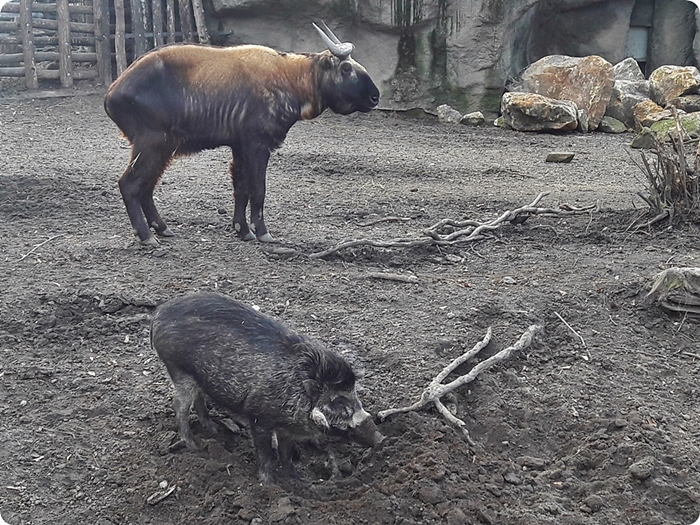
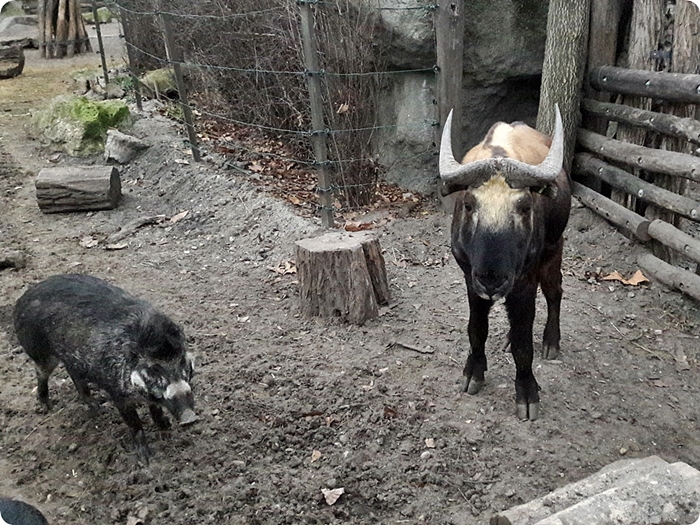
Visayan Warty Pig (Sus cebifrons negrinus) and Mishmi Takin (Budorcas taxicolor taxicolor)
Fővárosi Állat- és Növénykert, Budapest, Hungary
Photos © Krisztián Svábik
Combined species:
- Visayan Warty Pig, Sus cebifrons negrinus
- Sichuan Takin, Budorcas taxicolor tibetana
- Blackbuck, Antilope cervicapra
Institution(s): Fővárosi Állat- és Növénykert (Budapest, Hungary)
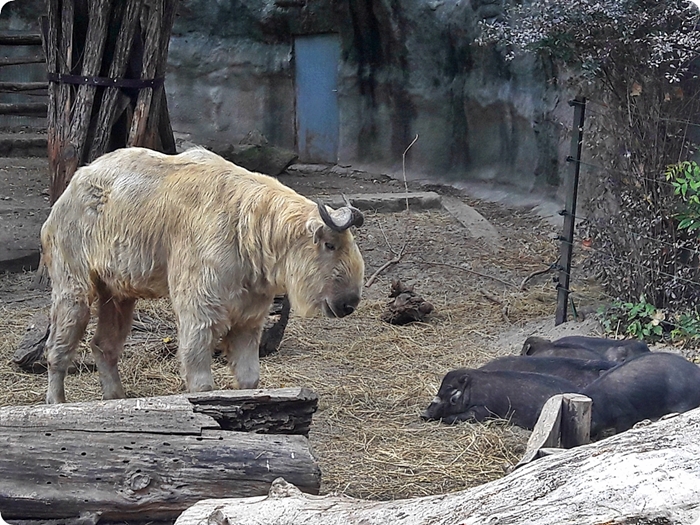
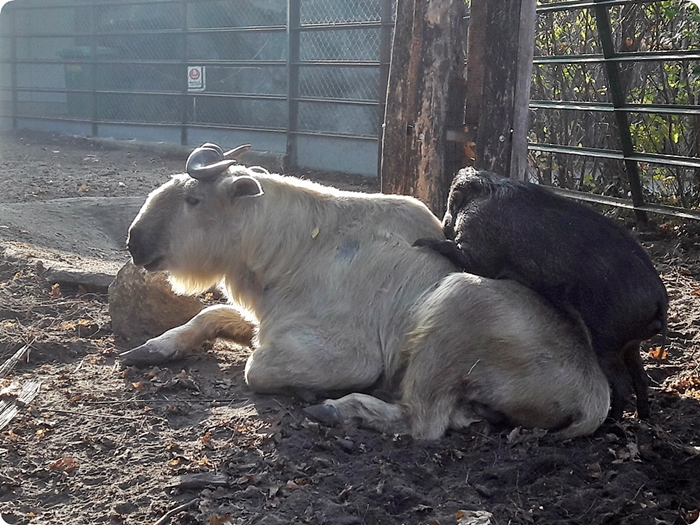
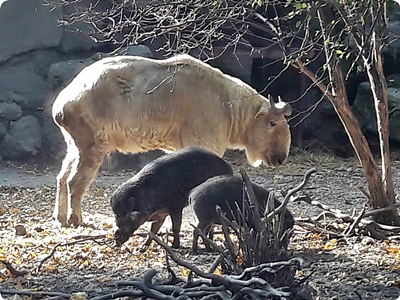
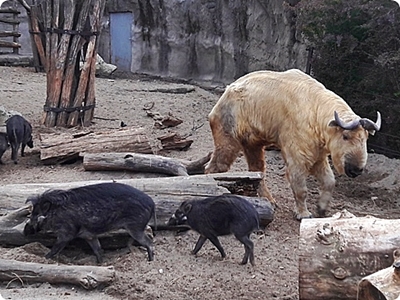
Visayan Warty Pigs (Sus cebifrons negrinus) and Sichuan Takin (Budorcas taxicolor tibetana)
Fővárosi Állat- és Növénykert, Budapest, Hungary
Photos © Krisztián Svábik
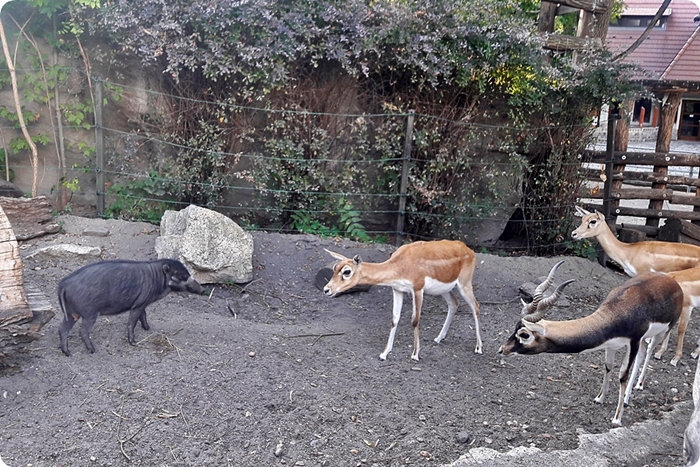
Visayan Warty Pig (Sus cebifrons negrinus) and Blackbucks (Antilope cervicapra)
Fővárosi Állat- és Növénykert, Budapest, Hungary
Photo © Krisztián Svábik
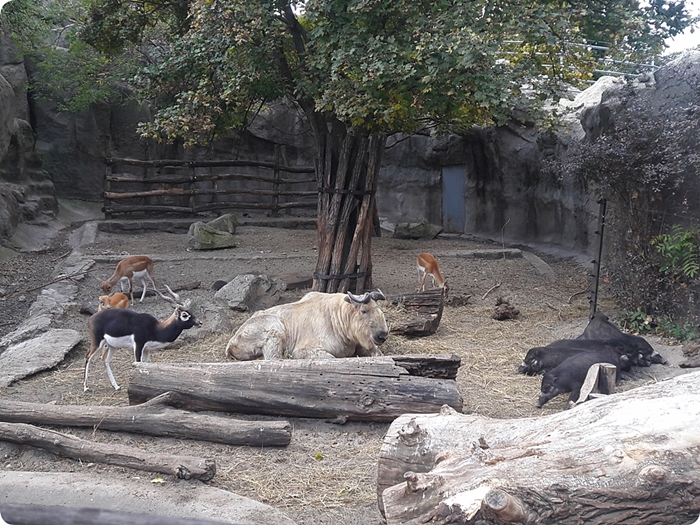
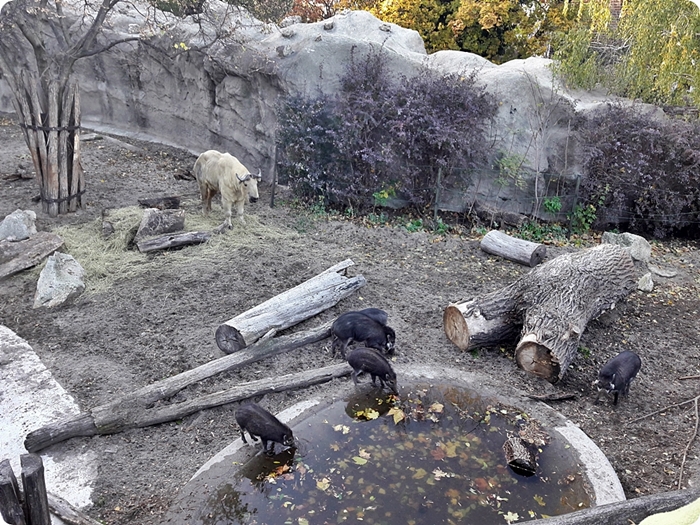
Visayan Warty Pig (Sus cebifrons negrinus), Sichuan Takin (Budorcas taxicolor tibetana) and Blackbuck (Antilope cervicapra) mixed exhibit
Fővárosi Állat- és Növénykert, Budapest, Hungary
Photos © Krisztián Svábik
Bearded Pig, Sus barbatus
Combined species:
- Bornean Bearded Pig, Sus barbatus barbatus
- Greater One-horned Rhinoceros, Rhinoceros unicornis
- Altai Wapiti, Cervus canadensis sibiricus
- Sika Deer, Cervus nippon
- Barasingha, Rucervus duvaucelii
- Javan Rusa, Rusa timorensis
- Malayan Sambar, Rusa unicolor equina
- Chital, Axis axis
- Blackbuck, Antilope cervicapra
- Persian Goitered Gazelle, Gazella subgutturosa subgutturosa
- Nilgai, Boselaphus tragocamelus
- Gaur, Bos gaurus
- Chinese Blue Sheep, Pseudois nayaur szechuanensis
- Armenian Mouflon, Ovis orientalis gmelini
Institution(s): San Diego Zoo Safari Park (Escondido, California, United States of America)
Eurasian Wild Boar, Sus scrofa
Combined species:
- Eurasian Wild Boar, Sus scrofa
- Crested Porcupine, Hystrix sp.
Institution(s): DierenPark Amersfoort (the Netherlands)
Combined species:
- Eurasian Wild Boar, Sus scrofa
- Red Fox, Vulpes vulpes
Institution(s): Tierpark Lange Erlen (Basel, Switzerland)
Combined species:
- Sunda Wild Boar, Sus scrofa vittatus
- Greater One-horned Rhinoceros, Rhinoceros unicornis
- Indian Muntjac, Muntiacus muntjak
- Tule Elk, Cervus canadensis nannodes
- Tonkin Sika Deer, Cervus nippon pseudaxis
- Dybowski’s Sika Deer, Cervus hortulorum hortulorum
- Barasingha, Rucervus duvaucelii
- Javan Rusa, Rusa timorensis
- Sambar, Rusa unicolor
- Chital, Axis axis
- Blackbuck, Antilope cervicapra
- Persian Goitered Gazelle, Gazella subgutturosa subgutturosa
- Saiga, Saiga tatarica
- Nilgai, Boselaphus tragocamelus
- Indian Gaur, Bos gaurus gaurus
- Armenian Mouflon, Ovis orientalis gmelini
- West Caucasian Tur, Capra caucasica
- Cretan Wild Goat, Capra aegagrus cretica
Institution(s): San Diego Zoo Safari Park (Escondido, California, United States of America)
Combined species:
- Eurasian Wild Boar, Sus scrofa
- Manitoban Elk, Cervus canadensis manitobensis
- Mouflon, Ovis orientalis musimon
Institution(s): Zoologická zahrada hl. m. Prahy (Czech Republic)
Combined species:
- Eurasian Wild Boar, Sus scrofa
- European Roe Deer, Capreolus capreolus
Institution(s): Zoologischer Garten Schwerin (Germany)
Combined species:
- Eurasian Wild Boar, Sus scrofa
- Fallow Deer, Dama dama
Institution(s): Attica Zoological Park (Athens, Greece), Naturschutz – Tierpark Görlitz (Germany)
Eurasian Wild Boar (Sus scrofa) and Fallow Deer (Dama dama)
Attica Zoological Park, Athens, Greece
Photo © Krisztián Svábik
Eurasian Wild Boar (Sus scrofa) and Fallow Deer (Dama dama) mixed exhibit
Attica Zoological Park, Athens, Greece
Photo © Krisztián Svábik
Eurasian Wild Boars (Sus scrofa) and Fallow Deer (Dama dama)
Attica Zoological Park, Athens, Greece
Photo © Alex Kantorovich
Combined species:
- Eurasian Wild Boar, Sus scrofa
- Fallow Deer, Dama dama
- European Roe Deer, Capreolus capreolus
- Red Deer, Cervus elaphus
- Mouflon, Ovis orientalis musimon
Institution(s): Nógrádi Vadaspark (Hungary)
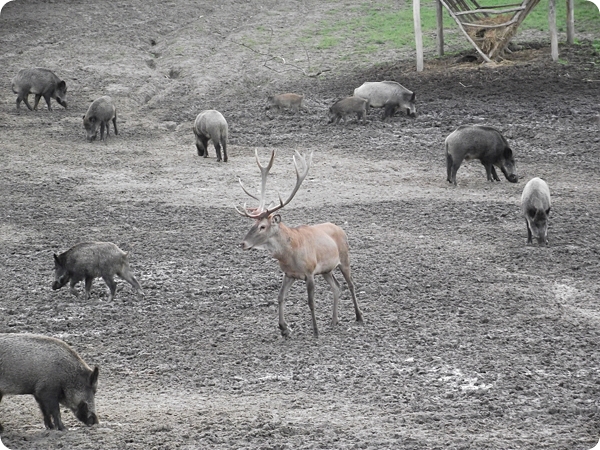
Eurasian Wild Boars (Sus scrofa) and Red Deer (Cervus elaphus)
Nógrádi Vadaspark, Hungary
Photo © Csaba Gyetván
Combined species:
- Eurasian Wild Boar, Sus scrofa
- Fallow Deer, Dama dama
- Red Deer, Cervus elaphus
- European Bison, Bison bonasus
- Mouflon, Ovis orientalis musimon
Institution(s): Xantus János Állatkert (Győr, Hungary)
Combined species:
- Eurasian Wild Boar, Sus scrofa
- European Bison, Bison bonasus
Institution(s): Zoo Aquarium de Madrid (Spain), Naturschutz – Tierpark Görlitz (Germany), Zoo Hoyerswerda (Germany), Alpenzoo Innsbruck (Austria), Skansen (Stockholm, Sweden), Zoopark Chomutov (Czech Republic), Nyíregyházi Állatpark (Hungary)
Eurasian Wild Boars (Sus scrofa) and European Bisons (Bison bonasus)
Nyíregyházi Állatpark, Hungary
Photo © Zsuzsa Petró
Eurasian Wild Boars (Sus scrofa) and European Bison (Bison bonasus)
Zoo Aquarium de Madrid, Spain
Photo © Shirley Carr
Eurasian Wild Boar (Sus scrofa) and European Bison (Bison bonasus) mixed exhibit
Zoo Aquarium de Madrid, Spain
Photo © Alex Kantorovich
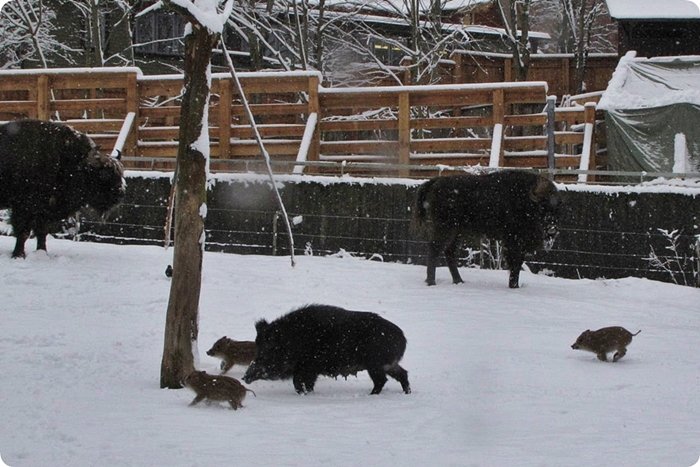
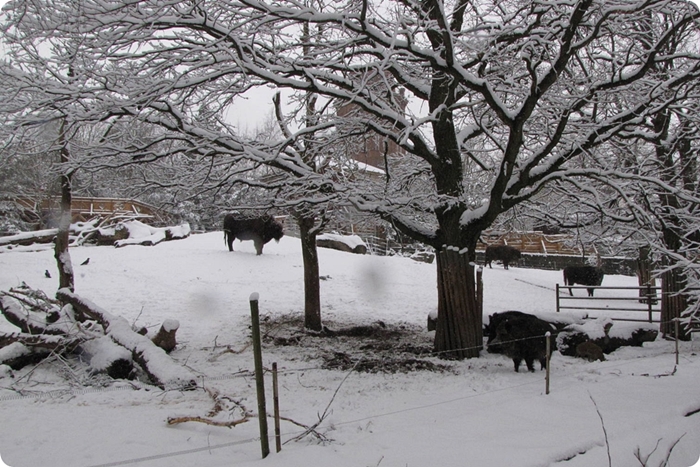
Eurasian Wild Boars (Sus scrofa) and European Bisons (Bison bonasus)
Skansen, Stockholm, Sweden
Photos © Susan Humphreys
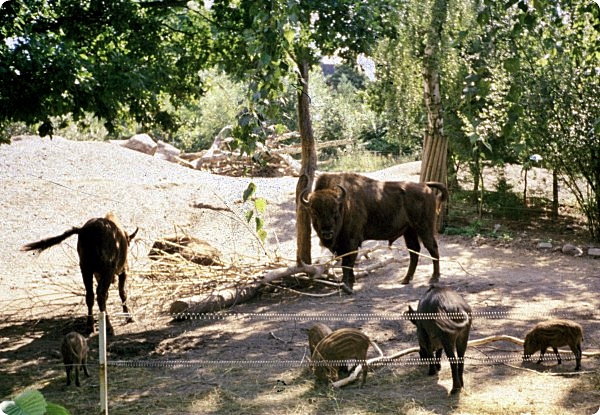
Eurasian Wild Boars (Sus scrofa) and European Bisons (Bison bonasus)
Skansen, Stockholm, Sweden
Photo © Isidro Martínez Pitarch
Combined species:
- Eurasian Wild Boar, Sus scrofa
- Javan Banteng, Bos javanicus javanicus
Institution(s): San Diego Zoo (California, United States of America)
Combined species:
- Eurasian Wild Boar, Sus scrofa
- Gayal, Bos gaurus f. frontalis
Institution(s): Khao Kheow Open Zoo (Chon Buri, Thailand)
Eurasian Wild Boars (Sus scrofa) and Gayals (Bos gaurus f. frontalis)
Khao Kheow Open Zoo, Chon Buri, Thailand
Photo © Alexander Meyer
Combined species:
- Eurasian Wild Boar, Sus scrofa
- Aoudad, Ammotragus lervia
Institution(s): Tierpark Weißwasser (Germany), Zoobotánico Jerez (Jerez de la Frontera, Cádiz, Spain)
Domestic Pig, Sus scrofa f. domestica
Combined species:
- Domestic Pig, Sus scrofa f. domestica
- Plains Zebra, Equus quagga
- Horse, Equus ferus f. caballus
- Wapiti, Cervus canadensis
- Sika Deer, Cervus nippon
- Fallow Deer, Dama dama
- Père David's Deer, Elaphurus davidianus
- American Bison, Bison bison
- Domestic Cattle, Bos primigenius f. taurus
- Zebu, Bos primigenius f. taurus
- Domestic Yak, Bos mutus f. grunniens
- Aoudad, Ammotragus lervia
Institution(s): Briarwood Ranch Safari Park (Bybee, Tennessee, United States of America)
Combined species:
- Kunekune Pig, Sus scrofa f. domestica
- Shetland Pony, Equus ferus f. caballus
Institution(s): Blackpool Zoo (United Kingdom)
Kunekune Pig (Sus scrofa f. domestica) and Shetland Pony (Equus ferus f. caballus)
Blackpool Zoo, United Kingdom
Photo © www.zoochat.com
Combined species:
- Domestic Pig, Sus scrofa f. domestica
- Donkey, Equus africanus f. asinus
Institution(s): Natur- und Tierpark Goldau (Switzerland)
Combined species:
- Domestic Pig, Sus scrofa f. domestica
- Donkey, Equus africanus f. asinus
- Zebu, Bos primigenius f. taurus
- Domestic Goat, Capra aegagrus f. hircus
Institution(s): The Buffalo Zoo (New York, United States of America)
Combined species:
- Domestic Pig, Sus scrofa f. domestica
- Sulawesi Babirusa, Babyrousa celebensis
Institution(s): København Zoo (Denmark), Fővárosi Állat- és Növénykert (Budapest, Hungary), Zoologischer Garten Berlin (Germany)
Combined species:
- Domestic Pig, Sus scrofa f. domestica
- Common Warthog, Phacochoerus africanus
- Llama, Lama guanicoe f. glama
- Fallow Deer, Dama dama
- Common Eland, Tragelaphus oryx
- Domestic Cattle, Bos primigenius f. taurus
- Ankole-Watusi Cattle, Bos primigenius f. taurus
- Domestic Water Buffalo, Bubalus arnee f. bubalis
- Greater Rhea, Rhea americana
Institution(s): Virginia Safari Park (Natural Bridge, Virginia, United States of America)
Combined species:
- Potbellied Pig, Sus scrofa f. domestica
- Llama, Lama guanicoe f. glama
- Miniature Zebu, Bos primigenius f. taurus
- Domestic Goat, Capra aegagrus f. hircus
- Barbados Sheep, Ovis orientalis f. aries
- Domestic Chicken, Gallus gallus f. domestica
Institution(s): Sunset Zoo (Manhattan, Kansas, United States of America)
Combined species:
- Domestic Pig, Sus scrofa f. domestica
- Alpaca, Vicugna vicugna f. pacos
- Blackbuck, Antilope cervicapra
- Nilgai, Boselaphus tragocamelus
- Scimitar-horned Oryx, Oryx dammah
- Domestic Goat, Capra aegagrus f. hircus
- Domestic Sheep, Ovis orientalis f. aries
Institution(s): Catoctin Wildlife Preserve (Thurmont, Maryland, United States of America)
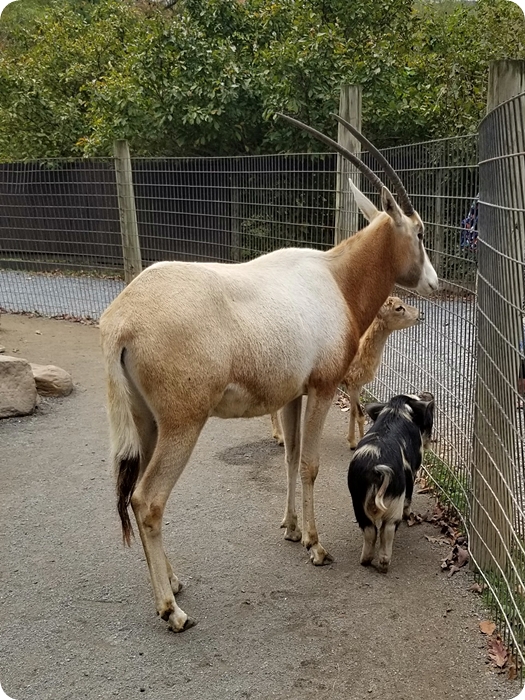
Domestic Pig (Sus scrofa f. domestica) and Scimitar-horned Oryx (Oryx dammah)
Catoctin Wildlife Preserve, Thurmont, Maryland, United States of America
Photo © Sarah Beaupre
Combined species:
- Potbellied Pig, Sus scrofa f. domestica
- West African Dwarf Goat, Capra aegagrus f. hircus
Institution(s): Zoo Frankfurt (Germany)
Combined species:
- Turopolje Pig, Sus scrofa f. domestica
- Indian Runner Duck, Rouen Clair Duck and Orpington Duck, Anas platyrhynchos f. domestica
- Pomeranian Goose, Anser anser f. domestica
- Swan Goose, Anser cygnoid
- Knob Goose, Anser cygnoid f. domestica
Institution(s): Tierpark Arche Warder (Germany)
Turopolje Pigs (Sus scrofa f. domestica) with ducks and geese
Tierpark Arche Warder, Germany
Photo © Monika Fiby
SUMMARIZE THE EXPERIENCES
The study lists species combinations and mixed exhibits with eight species of Suidae. Altogether 158 mixed exhibits with suids have been collected from 96 zoological institutions worldwide until April 2021. Combinations and mixed exhibits were not counted with domestic pig, only a few examples were added as an „interesting” supplements.
The results show that the most popular „participants” are the Red River Hog and the Common Warthog: the former has been listed in 52 and the latter in 50 mixed exhibit. Those folowed by Eurasian Wild Boar which has been listed in 20, Sulawesi Babirusa in 19, Visayan Warty Pig in 14, Giant Forest Hog in 2, Bushpig in 2 and Bearded Pig in 1 mixed exhibit.
In regard to species combinations Common Warthog has been socialized with 62 and Red River Hog with 55 different species. Those followed by Eurasian Wild Boar which has been combined with 26, Sulawesi Babirusa with 14, Bearded Pig with 13, Visayan Warty Pig with 11, Giant Forest Hog 7 and Bushpig with 3 other species.
Furthermore the study partly focuses on negative experiences in order to improve exhibit management criteria and trying to avoid combinations that have not been proved as successful.
Pigs are very defensive animals and for a long time it was thought that they are unsuitable for associations with other species (PUSCHMANN 1983).
Pigs – females also – can behave very aggressively against other species. Special care in this connection should be taken especially during the period of rearing young (HAMMER 2002).
The most serious fights occured between a Sulawesi Babirusa boar and a male Tonkean Macaque in Espace Zoologique de Saint-Martin la Plaine. The species were separated during rearing of young and over night. To avoid envy for food both species were fed separately. Despite this fact it repeatedly happened, that a piece of food fell to the ground for which they started to fight. Most injuries carried off the boar, which was not only bitten several times into its back but also lost his tail. The species had to be separated. Enclosure size was 1500 m² (HAMMER 2002).
Toronto Zoo has kept a four-year-old male Sulawesi Babirusa together with a pair of older White-handed Gibbon in an indoor exhibit. “Babirusa-proof” islands were created at the base of the gibbon climbing structures to protect some of the existing vegetation. The combination has proved unsuccessful as the male gibbon swiped at babirusa from above and on one occasion scratched or bit him. It was a minor cut but it bled a lot, causing visitors to panic. The babirusa was also stressed by the incident, running away as the gibbon chased him around the exhibit so after that they were separated. The two species had lived together for a few months (AZA Ungulate TAGs 2017).
A community with Babirusas and Patagonian Maras was created in Twycross Zoo in 1998. The species were separated during feeding time and over night. Agonistic interactions between the species were observed but were not as intensive that giving up was necessary. In one case the Babirusa fed on a newborn mara, but because this behaviour occured very seldom and the watchfulness of the adult rodents was increased so it was tolerated. Enclosure size was 1500 m² (HAMMER 2002).
Audubon Zoo has had a combination of their Sulawesi Babirusas (2.4) with two different Asian Small-clawed Otter groups (1.1 and 0.3). The babirusas have bred multiple times in the exhibit (AZA Ungulate TAGs 2017).
Jacksonville Zoo has tried out the same cohabitation, a breeding pair of babirusa lived together with a pair of abovementioned otter species. Both babirusa were two years old and both otters were approximately five years old when introduced to each other. Each species has their own holding space and the otters has an area they can enter but the pigs can not. The staff have not encountered many challenges with this exhibit, aggression is rare and in the worst cases has only resulted in superficial scratches on the babirusa (AZA Ungulate TAGs 2017).
In Chester Zoo we also can see this combination where a breeding pair of Babirusa and a group of Asian Small-clawed Otters (4.3) currently share an enclosure successfully. However, if the female babirusa becomes pregnant she will be separated from the otters at least a week prior to the birth to give her privacy to build her nest. The female will remain separated from the otters after giving birth as they pose a threat to the newly born piglets, the two species will be reintroduced when the piglets are around two months old and large enough for the otters to no longer be a danger. It is also worth mentioning that if the otters have pups the male babirusa will need to be removed from the enclosure, as he is likely to eat the pups when they start venturing out of the holts (ROWLANDS et al. 2018).
In Münchener Tierpark Hellabrunn a breeding pair of Sulawesi Babirusa and Malayan Tapir were associated in a 962 m² sized outdoor exhibit. Indoor holding areas were separated plus an adjacent outdoor enclosure for separation was available. Initially species were habituated to each other while being separated by a fence. When babirusas were introduced, tapirs were already habituated to the enclosure and babirusas were given the option to retreat. Tapirs were bitten by babirusas (ZIEGLER 2002).
Zoo Aquarium de Madrid has also kept Sulawesi Babirusa and Malayan Tapir in the same enclosure. The species were well together. The only concern is that, although the institutiuon had posters, many visitors thought the babirusa was the calf of the Malayan Tapir (DELCLAUX 2020, pers. comm.)
Twycross Zoo has mixed its breeding pair of Babirusas with a breeding group of Alpacas in a 1500 m² exhibit since 1998. Species were separated during feeding time and over night. Chases of Alpacas by Babirusa during breeding and the period of rearing young was occured so the pigs were separated (HAMMER 2002).
In Budapest Zoo an elderly pair of Sulawesi Babirusa lived together for a long time. When the male died the institution decided to bring a Minnesota minipig as a company for the female. In the first weeks they got along well but after that the domestic pig started to behave aggressively and shortly was dominant over the female babirusa. After that to avoid conflict and stress they were separated. Beforehand the zoo exhibited their babirusas together with Aldabra Giant Tortoise. It was only a temporary mix which lasted for a few months in the summer. No problems were reported with this combination.
It is worth mentioning an other mix with Sulawesi Babirusa and Domestic Pig. In 2006 five live piglets were born after mating a babirusa boar to a domestic sow in the Copenhagen Zoo following the introduction of two domestic gilts as temporary company for a lone male barbirusa. Two of the piglets died within the first week due to maternally induced trauma. None of the male and female domestic pig-babirusa hybrids were fertile. In the female, oocytes were generally degenerated. In the males, no spermatozoa were found and meiotic prophase did not seem to proceed beyond the pachytene stage (THOMSEN et al. 2010).
A young male Sulawesi Babirusa and an old female Lowland Anoa was successfully mixed in San Diego Zoo. The same combination has also successfully tried in Los Angeles Zoo. The female anoa was hand-reared and moved up to the babirusa exhibit when she was only 8-10 months old. The anoa was introduced to the female babirusa as the babirusa pair is kept separate, except for breeding. The babirusa female was an adult at this time. The species were kept together for 6-8 months at most as the anoa started to become overly aggressive with the babirusa around the time the anoa’s horns were becoming more prominent (AZA Ungulate TAGs 2017).
An unsuccessful mix with babirusa has also been reported from Los Angeles Zoo. A 2-3 years old babirusa pair was kept together with an adult Sarus Crane. One of the babirusa attacked the crane and inflicted severe bite wounds on the neck of the bird (AZA Ungulate TAGs 2017).
Out of pigs Common Warthog is one of the most frequently associated species. In Zoo Osnabrück both the combinations of Mt. Kenya Guerezas and White-naped Mangabeys together with the warthogs was successful, partly the animals even sought contact with each other (LAMMERS 2020, pers. comm.).
Detroit Zoo has reported an unsuccessful mix with two female Common Warthog and a breeding pair of Crested Porcupine. All the specimens were introduced as adults. The species were housed together on exhibit and separated when inside. They were fed separately in the indoor enclosure. The institution housed them together for less than two weeks then discontinued housing them together after one of the warthogs was quilled by the porcupines for the third time (AZA Ungulate TAGs 2017).
Franklin Park Zoo has also tried this combination with two female warthogs and a small group of Crested Porcupine (1.2). There was an aim to exclude the warthogs from entering the porcupine holding area and also how to give the porcupines a safe area to escape aggressive behavior from the warthogs: a line of cedar poles, measuring five feet above ground and separated on average by approx. 20 cm between each pole were installed across the width of the exhibit. This array has worked effectively to allow the porcupines access throughout all of the exhibit, but has prevented the warthogs from entering a portion of the exhibit directly in front of the porcupine holding area. Upon the initial introduction of the porcupines to the warthogs, as had been expected, the pigs made several aggressive attacks. Although Franklin Park Zoo has reported this as a successful coexistence the same problem occured here as mentioned earlier in Detroit Zoo as well: several times the warthogs received quills in their snouts or face, but no serious injuries were experienced and the quills were able to be removed by keepers by calling the affected animal off exhibit into the transfer chute and target training close to the mesh (AZA Ungulate TAGs 2017).
Safaripark Beekse Bergen previously have been mixed their Common Warthogs with Crested Porcupines and Meerkats. The meerkat slept on top of the warthog, but when he turned there was a danger to flatten them by the pig (VERSTEEGE 2020, pers. comm.).
In San Diego Zoo Safari Park Common Warthogs and Bat-eared Foxes live together since 2005. Foxes have dens and holes to separate themselves when desired (AZA Ungulate TAGs 2017).
Warthogs have very often been associated with other African hoofed mammals. Pécs Zoo tried to mix their warthogs with a group of female Grant’s Zebra (0.4) but due to zebra’s aggressive behaviour it was unsuccessful (NAGY 2020, pers. comm.)
San Diego Zoo has successfully combined its breeding group of Springbok (1.4) with a lone male Grant’s Zebra and Common Warthog. Springbok group consists of young specimens while both zebra and warthog were older individuals (AZA Ungulate TAGs 2017).
In Tierpark Hagenbeck a mixed exhibit with Common Warthog, Chapman’s Zebra, Defassa Waterbuck and Ostrich was created in a 2200 m² sized enclosure. Association of waterbucks and zebras was terminated and cannot be recommended, so the waterbucks were removed in 2001. A breeding pair of warthogs were introduced in 2000. At the beginning species where associated separately for hours, under permanent observation: first contacts of warthogs with ostriches in absence of zebras and first contacts with zebras in absence of ostriches. Established dominance hierarchy within this mixed exhibit is: 1. zebras, 2. warthogs, 3. ostriches. Burrows and holes dug by the warthogs are a permanent risk of injuries for other species – especially zebras – as they represent stumble traps. To minimize the risk of injuries, esp. for zebras, keepers have to check for- and if necessary refill ground holes dug by the warthogs within their daily routine works (ZIEGLER 2002).
Safaripark Beekse Bergen has created a 8,7 hectare big African Exhibit with 17 species in 1975. Species were separated over night, White Rhinoceros, Cape Buffalo, Bontebok, Greater Kudu, Sable Antelope, Impala, Aoudad and Warthog during feeding time as well, White Rhinoceros, Plains Zebra, Common Eland, Ankole-Watusi Cattle, Nyala and Bontebok during rearing of young, too. A breeding pair of Common Warthogs were later removed (HAMMER 2002).
A pair of Common Warthog housed together with a pair of Grant’s Zebra and a group of Giant Eland (3.2) in Houston Zoo. There was some aggression that started from the adult male eland, so later he ended up being separated. The warthogs and zebra got along with every other animals (AZA Ungulate TAGs 2017).
A very diverse African mixed exhibit exists in Toledo Zoo where Common Warthog (0.2), Grant’s Zebra (0.2), Greater Kudu (2.0), Impala (0.3), Dama Gazelle (1.1), Common Wildebeest (2.0), Ankole-Watusi Cattle (3.0), Masai Giraffe (1.4), Ostrich (1.2) and Helmeted Guineafowl (9.0) live together. The mentioned animal groups has been successfully mixed since 2005. Normally all the animals are out on exhibit from March/April through November and are pulled off exhibit in the winter. Giraffe, kudu, ostrich, and guineafowl are closed in each night. Introductions in the spring are challenging: giraffe and kudu are put out on exhibit first, later the wildebeest, then birds and other hoofstock – with exception of zebra – are put out on exhibit so they become comfortable in the area. Then zebra are put out separately (AZA Ungulate TAGs 2017).
Caldwell Zoo also has a multi-species African exhibit where Common Warthog (0.3), Grevy’s Zebra (0.3 + offspring), Greater Kudu (1.12 + offspring), Impala (1.0), Soemmerring’s Gazelle (1.0), Common Wildebeest (2.0), Topi, Ostrich (0.1), Crowned Crane (0.0.15), Sacred Ibis (0.0.6) and Helmeted Guineafowl (0.0.15) live together. The mentioned animal groups have been successfully mixed since the mid-1980s. All of the animals are shifted off the exhibit daily and housed in a night barn. The warthogs can kill and eat the bird species so the staff alternate them on exhibit (AZA Ungulate TAGs 2017).
In Toronto Zoo two male Common Warthog were exhibited together with a group of Southern White Rhinoceroses (2.2). Rhinos and warthogs shifted onto exhibit from two separate runways from the same building. Introductions of the species only lasted a few days, as warthogs kept digging under the gate to get back into their yards. The rhinos would left them alone for the most part, but occasionally chased them (AZA Ungulate TAGs 2017).
BREC's Baton Rouge Zoo has had a breeding pair of Common Warthog together with Mountain Bongos without any problem. Later Red River Hogs exhibited together with the antelopes (AZA Ungulate TAGs 2017).
Brookfield Zoo previously has had Common Warthog (0.3), Waterbuck (1.4) and Ostrich (1.2) in the same enclosure and it was very successful for over five years. Waterbuck and ostrich were a well-established group and warthog female with offspring were added later. Waterbuck and ostrich were held in holding yards and warthog had access to the new yard for several days prior to the addition of the waterbuck and ostrich. Warthog breeding was happened indoors during winter. The female gave birth in a separated yard from the mixed exhibit. The group was not reintroduced until young warthogs were three months old. The institution had frequent ostrich leg injuries possibly due to the terrain of this yard that had a steep slopping moat and numerous warthog wallows. Winter holding areas limited the amount of animals that could be displayed in this exhibit so ostrich were discontinued in this area mainly because the lack of adequate winter holding areas. So after that only warthogs and waterbucks exhibited together. Warthog were introduced to waterbuck when one year old. All animals shift easily on and off main exhibit into holding yards and stalls. Both species use their own shift gates, the warthog gate has bars added to it to restrict waterbuck from entering through it. Only warthogs are shifted into stalls for the night. This is a non-reproductive waterbuck group: the male was castrated at 16 months old and this contributed to the success of this mixed group. Later the warthogs were switched out with Red River Hogs (AZA Ungulate TAGs 2017).
Saint Louis Zoo was successfully mixed two male Warthogs with a lone female Cuvier’s Gazelle. All three animals were adults when introduced to each other and species were separated when brought into indoor enclosures (AZA Ungulate TAGs 2017).
An other gazelle species, a group of Slender-horned Gazelle (1.2) have been housed together with a pair of Common Warthog in Sedgwick County Zoo since 1999. All animals were introduced as adults. Only the gazelle are recommended to breed. Species are separated during rearing of young. Aggression between male gazelle and warthogs was a challenge and this has resulted in the death of gazelle (AZA Ungulate TAGs 2017).
Oklahoma City Zoo has also reported a lethal accident caused by a warthog. The pigs lived together with Reticulated and Rothschild’s Giraffe and Somali Ostrich where one of the warthogs killed an ostrich (AZA Ungulate TAGs 2017).
It is worth mentioning that Zoologischer Garten Magdeburg created an interesting multi-species exhibit for their African Elephants. In Africambo exhibit elephants are kept together with several species both indoors and outdoors. Indoors with different birds and outdoor exhibits areas are used by Grivet Monkey, Bat-eared Fox, Kafue Lechwe and Common Impala. There is a plan to add warthogs as well for this mixed-species community (ZooLex 2020).
In Cheyenne Mountain Zoo there are possible future plans for the warthogs and hippos to share the outdoor enclosure in the Water’s Edge: Africa exhibit, but that interaction has not yet been implemented (KOCH 2021, pers. comm.).
Beside the Common Warthog the other most frequently associated suid is the Red River Hog. Peoria Zoo has been successfully mixed a breeding group of Red River Hogs (2.4) and a family group of Guereza (2.2) since 2009. The institutiuon has had young hogs with young monkeys and never had any interspecies issues. During the introduction period large indoor and outdoor enclosures were used. The exhibit has many raised platforms and feeding stations for the monkeys so having privacy for both species is possible. Female hogs are separated prior to giving birth and for a short time after birth before being reintroducing to the male and the monkeys but after separating the adult females from each other the staff were never able to successfully reintroduce both adult females to the adult male (AZA Ungulate TAGs 2017).
Bronx Zoo has associated two primate species, De Brazza’s Monkey (1.0 + females + offspring) and Mandrill (1.1 or 0.2) together with a pair of Red River Hog in the Congo Gorilla Forest Exhibit. De Brazza’s group size varies but there is always a single adult male with females and offspring. De Brazza’s and Mandrills do not get along so they are alternated on exhibit later. The Mandrill & Red River Hog tolerance varies over time, with certain individuals, and with the presence of babies of either species. An adult male Mandrill who has not been exhibited with other species previously will have a different outcome than a young male who gets accustomed to hogs before becoming fully adult. There is plenty of space for primates to get above the hogs, even to their own hillside and multiple ground areas are also available to avoid conflict. All species have bred in this exhibit in the past. Piglets are not introduced to Mandrills until they are a good size (usually about 2,5-4,5 kg). This is a summer exhibit only (AZA Ungulate TAGs 2017).
San Diego Zoo has created two mixed-species exhibits in the Ituri Forest complex. The first one had Red River Hogs, De Brazza's Guenons and Spotted-necked Otters and African Forest Buffaloes, this side of the pathway had an otter pool with underwater viewing. On the other side of the pathway, there was another exhibit with otters mixed with Allen's Swamp Monkeys and Schmidt’s Guenons. The two sides were designed to feel like they were one space, but probably there is a wall separating the sides (HUFFMAN 2019, pers. comm.). It is worth mentioning that in the first coexistence lived an „unusual” suid specimen – probably a melanistic Red River Hog or Bushpig, but it was previously thought to be a Giant Forest Hog.
Red River Hogs has been combined with great apes as well. Bonobo and hog coexistence was successful in Colombus Zoo, but pigs were separated with electric fence when piglets were expected to prevent the bonobos from taking the babies (MEINELT, pers.comm.) (STEVENS 2020).
Safaripark Beekse Bergen has an interesting mix where Red River Hogs are exhibited together with small carnivores. The hogs live together with a large non-breeding group of Banded Mongoose (as all the males are castrated). The combination works well, but the institution has reported two biting incidents caused by the pigs (VERSTEEGE 2020, pers. comm.).
Saint Louis Zoo has positive experience keeping together a breeding pair of Red River Hog, a male group of Bat-eared Foxes (4.0) and Egyptian Geese (1.1). The species have been successfully mixed since 2013. All animals were adults when introduced to each other. The female Red River Hog is separated to give birth. The foxes have a portion of the habitat that only they can access (AZA Ungulate TAGs 2017).
In San Diego Zoo Safari Park a couple of young male Red River Hogs were lived together with Eastern Black Rhinoceros, Greater Kudu, East African Sitatunga, Ugandan Kob, Angolan Roan Antelope, White-bearded Wildebeest and Ankole-Watusi Cattle. It lasted only for a short time as they seemed to need better shelter which was unable to provide in this large field enclosure so the hogs were removed (AZA Ungulate TAGs 2017).
Zoo Osnabrück has had good experiences with keeping Red River Hogs, White Rhinoceroses and Chapman’s Zebras together. However, the socialisation with the zebras was the most difficult one (LAMMERS 2020, pers. comm.).
Red River Hog & Mountain Bongo combination have been tried out in many institutions. Sacramento Zoo successfully mixed a breeding pair of hogs with a breeding group of bongo (1.2). The hogs were closed in a separate yard at night. The species were housed in a separate enclosure and barn when the piglets were born for one month before introductions to the bongo in the big exhibit. Once the piglets were born and introduced to the bongo they were aggressive towards the antelopes. Once the institution acquired younger bongo that did not have experience in a mixed exhibit and when the hogs had piglets the mix was no longer successful (AZA Ungulate TAGs 2017).
In Los Angeles Zoo an old pair of Red River Hog and an old lone female Mountain Bongo were housed together successfully for two years (2002-2004). All animals were adults when introduced to each other. All individuals were closed in at night. Later a trio of female hogs arrived and lived together with the bongo for three years (2006-2009). The pair of hogs was easier to manage, although there were some fight initially between the male hog and the antelope. The trio was younger and more problematic in reference to manage them but there were no issues between the species (AZA Ungulate TAGs 2017).
Two male Red River Hogs live together with a small group of Mountain Bongos (1.2) in BREC’s Baton Rouge Zoo. The antelope breed and the institution holds the hogs off exhibit when the bongo are about to calve. This is a safety precaution and the zoo never had any problems (AZA Ungulate TAGs 2017).
In Franklin Park Zoo a non-breeding group of Red River Hogs (1.2) have been living together with a trio of female Mountain Bongos (0.3) since 2015. Bongos are housed in the barn directly attached to the mixed exhibit. The hogs are housed in an adjacent barn and transferred to and from the exhibit through a chute. Both species are housed in their own separate barns at night. Red River Hogs are all siblings and bongo group consists of two breeding cows and their offspring. Initial introduction of the female bongo to the pigs resulted in brief challenge displays from the male hog and an aggressive contact was made by one bongo cow as she flipped a male hog with her horns but no other negative interactions have ever been noted since that incident. There is a male bongo which is kept separate from the female in an adjacent bull yard and accessed to selected cows only for breeding. The bongo bull has never been accessed to the mixed exhibit with the Red River Hogs. This is a successful mix and there are plans to consider identifying one more species to manage in this exhibit (AZA Ungulate TAGs 2017).
Smithsonian National Zoological Park has successfully mixed a group of Red River Hog with a lone male Sitatunga since 2013. Hog females are contracepted. For introductions, visual access was provided through mesh allowing for nose to nose contact for up to a month. The species are exhibited together during the day only. Both species enters the mixed exhibit from their indoor holding area through a different gate. An elevated “island” was constructed in the center of the exhibit to provide the antelope refuge from the pigs if needed. The island is a mound of soil with a combination of large natural rock wall, precut vertical logs anchored in the ground and hot grass. A pile of tree limbs weaved together is used to create a natural barrier between the hog and sitatunga indoor enclosure access points. The majority of the altercations between the male hog and antelope occur at the end of the day as they are waiting to be let in for the evening. Their paths constantly cross and they become less tolerant of each other. Success of the mixed exhibit depends on the tolerance between the species and specimens; the institution has worked with three different male sitatungas ranging from 2-4 years of age.
Pigs are pushy and never back down to the male antelope. Usually the sitatunga runs away when approached but on occasion the sitatunga attempt contact with horns. Hog often wins, resulting in some minor injuries from biting that require treatment. Altercations have been periodically observed. One such aggression resulted in permanent separation between one female hog and the sitatunga after the hog was rolled down a slight incline with the horns. As a result, all trust was lost and the hog continuously pursued the antelope. Another female hog was given restricted access when her tolerance of the sitatunga allowed the male to demonstrate sexual behaviors to the extreme of mounting for several seconds. After that the male hog and male antelope continue to share the exhibit peacefully (AZA Ungulate TAGs 2017).
Disney’s Animal Kingdom Lodge has a very diverse species combination in its African savanna exhibit. The initial mix consisted of groups of Red River Hog (6.4), Nyala (1.8), Common Impala (0.3), Waterbuck (0.3), Steenbok (1.1), Thomson’s Gazelle (0.3), Ankole-Watusi Cattle (0.2), Okapi (0.1), Egyptian Goose (3.0), Spur-winged Goose, Rüppell’s Vulture (1.1), East African Grey Crowned Crane (4.0), Blue Crane, Wattled Crane, and Abyssinian Ground-hornbill (1.2). This savanna has been open since 2008, and it has changed over the years, but the core group has remained the same. Individual animals have changed and so have interactions based on this, but the core group of species on this exhibit has been the same for long time ago. Initial introductions with several of the other species – Red River Hog and Nyala – did have some moments of concern due to their curiosity but no aggression was reported. This was a family group of hogs: one adult male and the other five males are juveniles with two adult females and two juvenile females. The three adults were about two years of age when they arrived and were placed on the savanna exhibit. The young ones were introduced to the savanna at about four months of age. There have been a lot of changes with the management of these pigs. They had been separated due to breeding but after that they have gone back onto the mixed exhibit. They have been let out out each day around 9am and are brought back in between 2-3 pm. They spend the rest of their time in their own large yard. The hogs were very curious and spent all of their time exploring the savanna and wallowing. Most of the other animals were scared of them and gave them their space. Only when cornered will other animals turn to face off with the hogs. The staff watched for about 30 minutes right when we the hogs been released out, but they were out the rest of the time unsupervised and all was going well. The instution did not feed treats out on the savanna when the hogs were out due to possible food aggression with other animals. There was a breeding group of Nyala: they were a cohesive group, coexisted well with all other animals and only had tense moments with Red River Hogs. In case of Nyalathe staff did hold off for several months on putting calves on savanna due to other animals. Nyala calves are the youngest have been introduced the savanna at about 1-2 months old. Adult females became more aggressive notably to the hogs when they had young calves with them. Where normally the females walked away from where the hogs were, when they have calves they did not back down and charged the pigs. Red River Hog, Nyala, Steenbok, Okapi, Thomson’s Gazelle, Impala and hornbills have all bred on this mixed savanna exhibit. Previously the savanna was 2 hectares larger but was cut in half by a fenceline and they are now on the 2,4 hectare portion. The 2 hectare exhibit that was cut off is now another smaller savanna with a different group of species (AZA Ungulate TAGs 2017).
An other an newer combination in Disney's Animal Kingdom Lodge consists of Red River Hog (1.1), Plains Zebra (0.2), Common Impala (1.9), Thomson’s Gazelle (0.5), Waterbuck (2.6), Roan Antelope (3.0), Common Wildebeest (0.3), Reticulated Giraffe (2.2), Egyptian Goose (3.0) and East African Grey Crowned Crane (1.1). Currently the staff do not allow the Red River Hogs to remain on the savanna overnight as they seem to cause much more rooting damage to the habitat. It is important to make sure to keep perching available for the birds to either stand on or hide under if needed. Currently the only groups breeding out there are the Waterbuck and the Reticulated Giraffe (AZA Ungulate TAGs 2017).
In Zoo Aquarium de Madrid Red River Hogs were combined with Waterbucks and African Forest Buffaloes. No problems with the adult specimens but hogs have tried to attack the Waterbuck calves; as the mother defended the babies fiercely they did not harm them. The institution stopped keeping Waterbuck some years ago. The pigs are still together with the buffaloes and the species have a very good relationship. One of the male hogs use to be alot with the female buffaloes and with the calves without harming them at all (DELCLAUX 2020, pers. comm.).
San Diego Zoo kept successfully together a group of Red River Hog (1.2) with a lone female African Forest Buffalo for many years without problem. Hogs were separated for breeding from time to time (AZA Ungulate TAGs 2017).
Contrary the previous ones Rotterdam Zoo does not have good experiences with Red River Hog & African Forest Buffalo combination. The buffaloes were very aggressive towards the hogs and the zoo had some severe injuries by our pigs. The institution changed a few things in the enclosure but even after that the buffaloes kept on chasing the hogs (WEERMAN 2020, pers. comm.).
Zoo Dusiburg has a long tradition keeping Red River Hogs and Ankole-Watusi Cattles together since 1975. The species are separated during feeding, rearing of young and over night. Enclosure size is 2000 m² (HAMMER 2002).
Wild Place in Bristol mix their Red River Hogs with Reticulated Giraffes. The plan was to also mix them with Plains Zebra, however the zebra did not like the hogs. The institution used to also have free roaming guineafowl which also mixed with the pigs without any problems. The zoo is looking at mixing the hogs potentially with Western Lowland Gorilla in a few years’ time when they move the gorilla exhibit from Bristol Zoo to Wild Place in 2023 (WALKER 2021, pers. comm.).
It is worth mentioning that ZooParc de Beauval has a very diverse multi-species exhibit was built for their Hippopotamuses. Actually it is a large aviary which houses lots of African bird species. Separated paddocks for Red River Hogs and Lowland Nyalas were also created inside the aviary and have been designed that they could be let out into the other areas if desired.
Visayan Warty Pigs are more and more often kept in a mixed exhibit. Since 2015 San Diego Zoo started to house a female group of pigs together with their Malayan Tapirs. The four female pigs exhibited together with a non-breeding pair of tapirs and all animals were adults when introduced to each other. Food control was a challenge as the pigs were hard to keep out of areas (AZA Ungulate TAGs 2017).
ZooTampa at Lowry Park has also tried out the abovementioned mix successfully since 2016. A very old pair of warty pigs – both are 16 years old – live together with a breeding pair of tapir and its six-month-old calf. The tapir calf was on the ground when the staff began introductions with the dam and calf. The pigs had been with the male tapir for six months prior to adding the cow and calf. The enclosure provides the pigs with a safe place in case they want to move away from the tapirs (AZA Ungulate TAGs 2017).
Rotterdam Zoo was one of the first institutions housed their warty pigs together with a Greater One-horned Rhinoceros. The combination worked out well and the zoo stopped this mix because their „surplus” pigs had been transported to another zoo (WEERMAN 2020, pers. comm.).
In ZOO Planckendael the Visayan Warty Pigs are associated with a female Indian Rhinoceros. In the neighbouring enclosure the male rhino is living together with Reeves’ Muntjacs.
Dierenrijk was successfully mixed Visayan Warty Pig, Greater One-horned Rhinoceros, Nilgai and Hog Deer. This combination works very good and the institution has no problems at all (RIJNEN 2020, pers. comm.).
Zoo Basel has a unique multi-species exhibit with four mammal species: the Greater One-horned Rhinoceroses share their enclosure with Visayan Warty Pigs, Reeves’ Muntjacs and a group of Asian Small-clawed Otter. The two female Visayan Warty Pigs have been introduced to the exhibit in 2017. The otters were very daring at first and behaved provocatively towards the pigs, which did not bat an eyelid at their behaviour. The otters soon gave up this act and the warty pigs now get on well with them and other species as well sharing the exhibit (ZOO BASEL 2017). ZOO Wrocław also plans to combine their rhinos with warty pigs.
In Colchester Zoo the Visayan Warty Pig & Philippine Spotted Deer combination seems to be successful. The staff at first was afraid of if the pigs would predate upon the deer fawn but they have not experience this. The pigs are all male and it is conceivable that if there were females and piglets present then the deer may get harassed (BARWICK 2020, pers. comm.).
Zoo Leipzig currently keeps their Visayan Warty Pigs on their own but think about mixing them with Lowland Anoas (HOLLAND 2020, pers. comm.).
Budapest Zoo has two groups of Visayan Warty Pigs. The breeding group has their own enclosure. The other group is consists of the separated four young males and one spayed female. This latter „surplus” animals were previously housed together with a lone older male Sichuan Takin. The exhibit has been divided into two parts and between them a wooden fence was built through which only the pigs could pass and provided a „takin-proof” side for them. Both species has their own indoor holding area. In the course of time the two species have more and more often been seen in close proximity to each other. Male pigs has been observed many times scratching themselves on the takin which seemed to enjoy the company. Blacbucks as a third species has also been mixed with them for a while without any problem.
Bearded Pig is one of the rarest suid species in captivity even so one mixed exhibit is reported with them. San Diego Zoo Safari Park kept their Bearded Pigs together with many other hoofed mammals in a 14 hectare big Asian exhibit. In 2000 the species and group composition were the following: Bornean Bearded Pig (3.0), Greater One-horned Rhinoceros (5.8), Altai Wapiti (7.10), Sika Deer (9.15), Barasingha (5.15), Javan Rusa (7.11), Malayan Sambar (13.17), Chital (6.16), Blackbuck (6.25), Persian Goitered Gazelle (5.13), Nilgai, Gaur (14.18), Chinese Blue Sheep (2.3) and Armenian Mouflon (28.44). The Bearded Pigs were not exhibited for very long as one of them was hit by a Gaur and came up lame for quite a while. They were observed harassing newborn deer fawns (AZA Ungulate TAGs 2017).
DierenPark Amersfoort mixed their Eurasian Wild Boars with Crested Porcupines in a 250 m² enclosure. All the animals have had separated indoor enclosures and outdoor they were together all year round. According to the experiences the rodents need separated outdoor enclosure for retreat (HAMMER 2002).
In 1995 a community of Wild Boar and Fallow Deer in Tierpark Görlitz had to be given up due to continuing anxiety of the deer. Fisrt both enclosures were separated again by a low fence, the deer were able to use the enclosure of the pigs. Nevertheless during such visits repeatedly attacks of the deer by the pigs occured, therefore the fence was raised again and the two species were totally separated. Size of the mixed exhibit was 1000 m² (HAMMER 2002).
Prague Zoo housed their Eurasian Wild Boars together with Manitoban Elk and Mouflon. Problems were always between mouflons and elks and no incidents were reported with pigs (BRANDL 2020, pers. comm.).
Several institutions has tried out the Eurasian Wild Boar and European Bison combination. Alpenzoo Innsbruck keeps the species in a 1200 m² big exhibit together. Ther animals are separated during feeding time and over night. One lethal accident was also reported: a Wild Boar died after an attack of a Wisent. Apart from this bisons are showing agonistic behaviour on a very rare occasion. The Skansen in Stockholm has been keeping the species together since 1975, enclosure size is 1500 m². Animals are separated over night. In 1997 Tierpark Görlitz has had a very old female bison and associated her with a small group of wild boars as enrichment which was worked well. Enclosure size was relatively small, 400 m² (HAMMER 2002).
In Zoo Aquarium de Madrid no problem was reported with the abovementioned combination (DELCLAUX 2020, pers. comm.).
San Diego Zoo was successfully mixed a breeding group of Eurasian Wild Boar (1.3 + offspring) with a breeding group of Banteng (1.6 + offspring). Introduction of the species was lasted over three weeks. Managing pigs during banteng births was challenging (AZA Ungulate TAGs 2017).
Zoobotánico Jerez kept its Eurasian Wild Boars together with Aoudads in a 1000 m² enclosure since 1996. The species were separated during rut, rearing of young, feeding time and over night. No problems have been observed. In the mating season some dominant male Barbary Sheep had some aggressive reaction towards the Wild Boars but never any injury was reported (HAMMER 2002).
ACKNOWLEDGEMENTS
I would like to thank all the persons very much who helped to improve this short summary with providing information and photographs as well, in particulare:
Clive BARWICK Curator (Colchester Zoo, United Kingdom), Dr. Pavel BRANDL Curator (Zoologická zahrada hl. m. Prahy, Czech Republic), Eugéne BRUINS Zoo Director (Zoo Hoyerswerda, Germany), Melody CORTÉS Veterinarian & Head of Conservation Department (Oasys MiniHollywood, Tabernas, Spain), Maria DELCLAUX Curator of Mammals (Zoo Aquarium de Madrid, Spain), Dr. Peter DOLLINGER (Zoo Office Bern, Switzerland), Lajos ENDRÉDI Curator (Szegedi Vadaspark, Hungary), Monika FIBY Landscape Architect, Zoo Designer and Consultant (ZooLex Zoo Design non-profit Organization, Manager and Chief Editor), Catrin HAMMER Curator (Naturschutz - Tierpark Görlitz, Germany), Sander HOFMAN General Curator (ZOO Antwerpen – ZOO Planckendael – ZOO Serpentarium, Belgium), Ruben HOLLAND Curator (Zoo Leipzig, Germany), Brent HUFFMAN Lead Keeper & Zoologist, AZA Ungulates Team (Toronto Zoo, Ontario, Canada), Kris JANSEN Head Keeper (Safaripark Beekse Bergen, Hilvarenbeek, the Netherlands), Alex KANTOROVICH Euroasian Regional Coordinator at Species360 and Curator (Hai Park, Kiryat Motzkin, Israel), Jenny KOCH Marketing Director (Cheyenne Mountain Zoo, Colorado Springs, Colorado, United States of America), Sarah LAFAUT Curator of Mammals (ZOO Antwerpen – ZOO Planckendael, Belgium), Katja LAMMERS Scientific Assistant (Zoo Osnabrück, Germany), Jonas LIVET Chief Executive & Project Officer (Fox Consulting, Haguenau, France), Antal NAGY Zoo Educator (Xantus János Állatkert, Győr, Hungary), Zsuzsa PETRÓ Head of Department (Nyíregyházi Állatpark, Hungary), Stephan RIJNEN Curator (Dierenrijk, Mierlo, the Netherlands), Klaus RUDLOFF Curator Emeritus (Tierpark Berlin, Germany), Curby SIMERSON Associate Curator of Mammals (San Diego Zoo, California, United States of America), Elodie TRUNET Veterinarian & Curator (Zoo du Bassin d'Arcachon, La Teste de Buch, France), Tamás VERESS Curator (Miskolci Állatkert és Kultúrpark, Hungary), Lars VERSTEEGE Curator (Safaripark Beekse Bergen, Hilvarenbeek, the Netherlands), Will WALKER Animal Manager and EEP Coordinator of Red River Hog (Wild Place Project, Bristol Zoological Society, United Kingdom), Janno WEERMAN Curator/Team Leader Asia Section (Diergaarde Blijdorp, Rotterdam, the Netherlands)
As well as I would like to thank all the persons very much who helped to improve this document with providing further photographs, their names are listed below:
Nick ATHANAS, Thomas BAUER, Sarah BEAUPRE, Mario BERNDTGEN, Edward BREEZE, David BROWN, Tyler BUTLER, Shirley CARR, Josh CHAMBERLAIN, Christian DRIESEN, Bernard DUPONT, Luis FEHRMANN, Marc FISHKIND, David FREELY, MaryAnn FULLER, Allan GALWAY, Ben GILBERT, Örs GÖRÖG, Logan GREEN, Csaba GYETVÁN, Nick HADAD, Alan HILL, Christopher HOLLAND, Marcel HOLTROP, Fred HOOD, Susan HUMPHREYS, Kåre JENSEN, Bjorn KREBBERS, Jamie LUCAS, Paco Micó MARTÍNEZ, Isidro MARTÍNEZ PITARCH, Anita MAZÁCS, Christopher McLAUGHLAN, Alexander MEYER, Gabriella MÓTYÁN, Scott RICHARDSON, Erik ROELS, Maarten de RUITER, Tim SAGORSKI, T. SANTIAGO-GAMBLE, Stephen SHELLEY, Matt THOMPSON, Alan TORRES DWYER, Quentin VANHOOSE, Théo VONNEZ
References:
AZA Ungulate TAGs 2017. Ungulate Taxon Advisory Groups Mixed-species Exhibit Manual. Association of Zoos and Aquariums, Silver Springs, MD. pp 1031.
HAIGWOOD, J. 2005. Pig, Peccary and Hippo TAG Mixed Species Brochure, Los Angeles Zoo
HAMMER, G. 2002. Mixed species exhibits involved mammals: stock report and problems. Dissertation. Naturwissenschaftliche Fakultät Universität Salzburg.
ROWLANDS, T., TREANOR, A., EDGE, K. & ANKERS, F. 2018. (eds.) EAZA Best Practice Guidelines Babirusa (Babyrousa). 1st edition, NEZS Chester Zoo
STEVENS, J. 2020. (ed.) EAZA Best Practice Guidelines - Bonobo (Pan paniscus). Royal Zoological Society of Antwerp
THOMSEN et al. 2010. Meiotic Studies in Infertile Domestic Pig-Babirusa Hybrids. Cytogenetic and Genome Research.
ZIEGLER, T. 2002. Selected Mixed Species Exhibits in Zoological Gardens. Primate Report 64. Selected Mixed Species Exhibits of Primates in German Zoological Gardens. Pp. 7-71.
ZIEGLER, T. 2002. Selected Mixed Species Exhibits in Zoological Gardens. Primate Report 64. Selected Mixed Species Exhibits with Mammals without Primates Involved. Pp. 72-84.
ZSCHEILE, D. & ZSCHEILE, K. 2018. Säugetiere – Zootierhaltung. 6., überarbeitete Auflage.Verlag Europa-Lehrmittel, Nourney, Vollmer GmbH & Co. KG, 42781 Haan-Gruiten
www.zoobasel.ch
www.zooinstitutes.com
www.zootier-lexikon.org
Comments

